#source: lamas with hats
Explore tagged Tumblr posts
Text
Tony: "Oh god what is that?“
Y/N: "It’s new meds Tony, ✨mood stabilizing meds✨ They’re gonna show us the way to stability.“
Tony: "Guys, You do know that there's no actual guarantee, it will work right-"
Y/N: "Shun the non believe!"
Loki: "Sssshhhhuuunn!"
Bucky: "Sssshhhhuuunn!"
#incorrect quotes y/n#quotes#incorrect quotes loki#incorrect qoutes#incorrect quotes marvel#loki laufeyson#gay#incorrect quotes avengers#loki laufeyson x male reader#meme#incorrect bucky barnes#incorrect bucky quotes#tony x male!reader#avengers x male reader#source: lamas with hats#lamas with hats
494 notes
·
View notes
Text
Yena: Why would you think any of this was a good idea?
Riki: Probably because I’m a dangerous sociopath with a long history of violence.
Yena: ... Oh.
Riki: I don’t know how you keep forgetting that.
#incorrect quotes#wildfyre#yena youngblood#riki poppet#vtuber#vtubers#chromashift#source: lamas with hats
1 note
·
View note
Text
So another of my tin foil hat theories is, it's not just Omega who can take midichlorian donation--it's all of the Batch. Grab the Reynold's Wrap and some Thin Mints!
At the end of S1 when Nala Se arrives at Tantiss she says to Hemlock 'what the Emperor wants isn't possible'. So, she already knows what Hemlock is up to.
In Season 2, Lama Su suggests grabbing Omega as leverage, because Nala Se has been rotting in a cell, refusing to cooperate. Hemlock snags Crosshair, uses him to bait the Batch, gets Omega. As we know from S3, Nala Se instantly starts blackholing Omega's test results. We find out why in episode 3 when Omega and Crosshair are spared death because due to a series of unfortunate events, one of Omega's samples gets through and is positive for the ability to accept a donation of midichlorians. I.e., Omega can get More Stronger at wielding the Force, which the Emperor naturally would want for himself, for cloned bodies for him to jump into (Rise of Skywalker), etc.
Now, Nala Se immediately began deleting Omega's samples, and per S1, she already knew what this project was about--so she knew that she had accomplished what the Emperor wanted, she was just gaslighting gatekeeping girlbossing her way through 'WOW SCIENCE IS HARD' and while Hemlock suspects her he can't do this without her so he's kinda stuck.
Where the rest of the Batch come into this is part meta and part S1.
In Season 1, Lama Su indicates he doesn't care who out of the Batch they can get back as long as they can get one. This is highly relevant because we're initially lead to believe it's only Omega they want, because Omega is a pure copy of Jango, and thus a source of DNA for them to keep using since Boba is long gone, as is Jango. (This doesn't make sense scientifically but, you know, whatever.)
As we find out, though, she's not. Furthermore, Omega isn't just an experimental clone, she's the first experimental clone. She was made before the Batch, suggesting they might even be derived from her, or, at a minimum share numerous of her traits. For example, the ability to accept midichlorians.
Nala Se's comment to Hemlock implies she knows about the desire for this process which in turn suggests the Kaminoans themselves were already trying to do it (maybe even in conjunction with Hemlock, who later left; he and Nala Se clearly know one another quite well). But the Kaminoans may have undertaken it as a selling point to the Republic. Hey, Jedi numbers low? No problem! Force sensitive clones WITH inhibitor chips so they do anything you want!
But the Emperor doesn't want that, he wants to make himself a new fresh body to live in forever. So they blow Tipoca City to pieces and kidnap Nala Se, wanting her to finish the project. Except she already has, and the results are in the wind. Except...for Crosshair.
Now, Hemlock says Crosshair was ruled out long ago. As we saw, Nala Se was destroying Omega's samples. ...was she also destroying Crosshair's? She might have been; we have no way of knowing, having never seen him be tested. Nala Se may have bided her time, deleting Cross' samples until Hemlock gives up on him and chucks him in with the others to be made into a Clone X. Whew! Bullet dodged. Except then Omega is captured. Fuck! Back at it again.
Meta-reason: when asked about the new seasonal posters, someone noted that there's a red underlight glow on Omega and the original Batch members, i.e. not on Echo. And on no one else. If this is danger, what danger are they all equally in which Echo isn't? Well...Echo isn't derived from Omega...
Final fold for this particular hat: since Cross and Omega have escaped we've been given no insight into what's happening in Tantiss. This isn't, IMO, on accident; it's likely Hemlock got all this information out of Nala Se one way or another. And that could be why CX-1 said 'they're coming for all of you'. He may have meant all of the Batch, since he was talking to Crosshair.
Did Rex and Howzer look at the rest of those targets on the list? Omega is the primary one, obviously, because she can be leveraged against Nala Se, who tbh couldn't give a shit about the rest of the Batch. But as Lama Su said: any one will do.
This works much, much better than Omega being the most specialist girl protected by her younger brothers. That's tired. Instead it becomes 'family created for one purpose decide to do literally anything else with their lives, against all odds'. Vastly more interesting.
And one last thing which is less tinfoil-hat-making and more pondering: those medical records on Nala Se's datapad. They're going to be relevant. Perhaps there's locked or hidden information in there which, once Tech re-surfaces, they can get into. We'll see.
70 notes
·
View notes
Text
Arthur: Why would you think any of this is a good idea?
Dutch: Probably because I'm a dangerous sociopath with a long history of violence.
Arthur: ...Oh.
Dutch: I don't understand how you keep forgetting that-
#rdr2 spoiler#red dead redemption 2#red dead redemption#rdr2#incorrect rdr2#arthur morgan#dutch van der linde#incorrect quote#incorrect quotes#incorrect rdr2 quotes#incorrect red dead redemption 2#source: lamas with hats
218 notes
·
View notes
Text
Adam: You hear that? That's the sound of forgiveness.
Blake: That's the sound of people dying, Adam!
Adam: And that is what forgiveness sounds like. Screaming & then silence.
#rwby#team rwby#blake bellodona#adam taurus#white fang#rwby white fang#incorrect rwby quotes#incorrect quotes#source: lama's with hats
15 notes
·
View notes
Conversation
XANATOS: How did you think any of this was a good idea?
DEMONA: Probably because I'm a dangerous sociopath with a long history of violence.
XANATOS: Oh.
DEMONA: I don't understand how you keep forgetting that.
56 notes
·
View notes
Text
Irwin: Why would you think any of this was a good idea?!
Humphrey: Probably because I’m a dangerous sociopath with a long history of violence.
Irwin: ...oh
Humphrey: I don’t understand how you keep forgetting that.
8 notes
·
View notes
Text
Baltus Hafez: How did you think any of this was a good idea?
Meela Nais: Probably because I'm a dangerous sociopath with a long history of violence.
Baltus Hafez: Oh.
Meela Nais: I don't understand how you keep forgetting that.
#incorrect the mummy quotes#incorrect quotes#the mummy#the mummy returns#baltus hafez#meela nais#cult of imhotep#dangerous psychopath#source: lamas with hats
14 notes
·
View notes
Conversation
Roman: Remus! Why is there a dead man in our house?!
Remus: Oh, hey, how did he get here?
Roman: REMUS!, what did you do?!
Tell me, exactly what you were doing before I got home!
-
Remus: Alright, well I was upstairs.
Roman: Okay.
Remus: I was, I was sitting in my room.
Roman: Yes.
Remus: Eating a book.
Roman: Go on.
Remus: And uh, well this guy walked in.
Roman: Okay.
Remus: So I went up to him.
Roman: Yes.
Remus: And I, uh, stabbed him 37 times in the chest.
Roman: REMUS! THAT KILLS PEOPLE!
#sanders sides#remus#roman#tw. murder mentioned#shitpost#incorrect quotes#source: lamas with hats#do not edit or change
372 notes
·
View notes
Text
Analysing Douma’s Blood Demon Art Based on Tibetan Buddhism

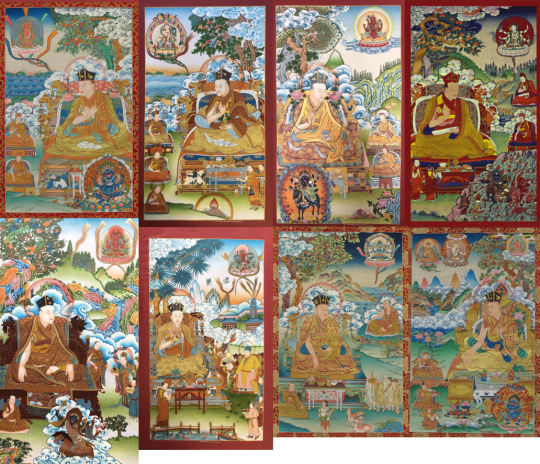
Frozen Cloud
Clouds are a very recurring element in tibetan buddhism with Karmapas. For those who missed my last post, the Karmapa is the bearer of the Black Crown(the hat Douma wears), hence he is sometimes known as the Black Crown Lama.
I always found it curious how Douma’s Frozen Clouds appear behind from him, surrounding him, instead of being shot with his fans. I then realized they’re not just an attack, they’re also a defense so if they surround Douma like this they can work as a shield because they keep demon slayers far away from him. But now I think this could have a symbolic aspect to it because in quite a lot Karmapa paintings, the Karmapas are surrounded by clouds, those generally behind him.
You can see a bit of similarity between this Douma panel and these Karmapa illustrations. Notice how in these Karmapa illustrations above the clouds are behind the Karmapas surrounding them like Douma’s Frozen Clouds. If Douma still had his Black Clown hat in this panel, the comparison would be perfect. The cloud is a common symbol in Tibetan Buddhism representing the creative power of the mind and the ability to take any form.
“In Tibetan Buddhism the symbol of the cloud is of such far-reaching importance, that a glance upon Tibetan Thankas (scrolls) or temple-frescoes would suffice to convince the beholder. The figures of Buddhas, Bodhisattvas (enlightened beings), saints, gods and genii manifest themselves from cloud-formations which surround their haloes. The cloud represents the creative power of the mind, which can assume any imaginable form. The white cloud especially (or even a cloud shining in delicate rainbowcolours) is regarded as the ideal medium of creation for the enlightened or enraptured mind, which manifests itself on the plane of meditative vision as sambhogakāya, the mind-created 'body of delight'.”
“Even the earlier Sanskrit-Buddhism speaks of the 'Cloud of Truth' or the 'Cloud of the Universal Law' (dharma-megha), from which descends the rain of bliss and liberating knowledge upon a world burning with passions.”
“Thus the 'White Cloud' becomes the symbol of the Guru's wisdom and compassion, and therefore 'the Way of the White Clouds' hints at the same time at the way of spiritual unfoldment, the way of a pilgrimage that leads to the realisation of final completeness.”

Based on all this, a cloud can be used to describe Douma’s nature. As Kanao pointed out, he’s able to change the form of his face to match any social situation just like a cloud can take any form. So in this case the “Cloud of Lies” because he prefers to spread lies rather than spread knowledge.
Unsui is a term specific to Zen Buddhism which literally translates as "cloud, water" comes from a Chinese poem which reads, "To drift like clouds and flow like water." Helen J. Baroni writes, "The term can be applied more broadly for any practitioner of Zen, since followers of Zen attempt to move freely through life, without the constraints and limitations of attachment, like free-floating clouds or flowing water."
Attachment: A deluded Mental factor or Perception that observes a person or object and regards it as a cause or source of Happiness, and wishes for it. A deluded mental factor that observes a contaminated object, regards it as a cause of happiness, and wishes for it.
“He was sometimes consulted by his believers, and seeing them crumble under the weight of their desires, be it for money, status or love, seemed to be too foolish for him, but he felt curious what the feeling was like. He had money, status, and an almost-immortal body, but he didn't feel anything special, so he switched partners every now and then to try to play the childish game of love.”
Another comparison can be made between Douma and a cloud based on the term unsui. Accordind to the kny 2nd fanbook, Douma thought it was stupid of his followers to crumble over money, status or love. He even had money and status, but didn’t feel anything about it and never felt love until death as he said it himself when he told Shinobu he fell in love for the first time with her when he was dead. That’s also why he couldn’t regenerate his head like Akaza and Muzan, because he had no desires and attachments to his past life and current life like them. While he was alive he had no material attachments nor emotional attachments.
He moved freely through life, without the constraints and limitations, like free-floating clouds. He thought Gods, Buddhas, Heaven and Hell, and divine punishment were just constrainsts and limitations invented by humans to keep evil people from drinking the “sweet nectar” and so that mentally weak people would be able to live with themselves.
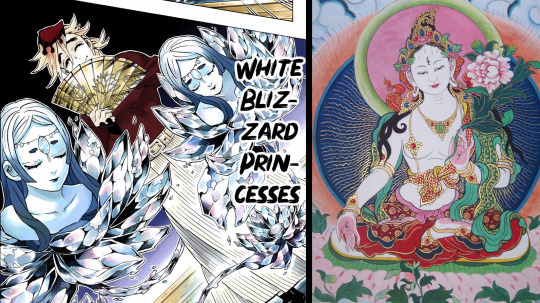
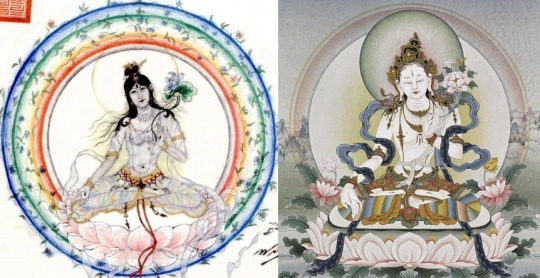
White Blizzard Princesses
Of the 21 Taras, the two most popular are Green Tara and White Tara. Tara’s name in Tibetan is Dolma, and you can see then that White Tara’s Tibetan name, Dolkar, is a short form of Dolma Karpo, which means White Dolma. Tibetans pray to White Tara especially for health, healing and longevity/long life. She offers healing to our wounds, whether it is our bodies or our minds that have been hurt.
As White Tārā she expresses maternal compassion and offers healing to beings who are hurt or wounded, either mentally or psychically. White Tara embodies compassion, purity, grace, serenity and the love of a mother for her child. White Tara is often referred to as the "Mother of all the Buddhas". Tara is very close to sentient beings, like a mother to her children.
Her pure compassion for our suffering which is thought to be greater even than a mothers love for her child is symbolized in images of White Tara by her white color. White Tara has 7 eyes — with an eye in her forehead, and one on each hand and foot — symbolizing her compassionate vigilance to see all the suffering of the world.
She is very quick to fulfill our wishes and to grant us happiness and a long life, as well as to help us develop wisdom. Tara is seen as the very embodiment of this wind—resulting in her ability to fulfill our wishes and prayers swiftly. It is said that living beings receive Tara’s blessings as swiftly as the wind moves because she is the manifestation of the wind element of all Buddhas.
“Within Tibetan Buddhism Tārā is regarded as a Buddha of compassion and action. She is the female aspect of Avalokitesvara and in some origin stories she comes from his tears that were shed in pity as he observed the vast suffering in the world.
Tārā originated not in Buddhism but in Hinduism, where she was seen as a Mother Goddess. Known as a manifestation of Kali, the queen of time, Tārā was seen as the unquenchable hunger that propels all life. Hindu oral tradition states that Tārā first appeared during the Hindu creation myth of the churning of the ocean. In this legend, Shiva has drunk the poison that was created from the churning of the ocean, thus saving the world from destruction, but has fallen unconscious under its powerful effect. Tārā appears and takes Shiva on her lap. She suckles him, the milk from her breasts counteracting the poison, and he recovers. This myth is reminiscent of the myth in which Shiva stops the rampaging Kali by becoming an infant. Seeing the child, Kali's maternal instinct comes to the forefront and she becomes quiet and nurses the infant Shiva. In both cases, Shiva assumes the position of an infant vis-à-vis the goddess.”
Tara was at one time a human princess who dedicated her life to love and protection of all. She is an example of the soul's aspiration to develop qualities of love, compassion, wisdom and joy. White Tara is sometimes called the Mother of all Buddhas and she represents the motherly aspect of compassion. Her white color signifies purity, wisdom and truth.

The White Tara was incarnated later as the chinese Princess Wencheng. I initially thought Douma’s White Blizzard Princesses’ head necklace with a pendant on the forehead was supposed to a reference to White Tara’s third eye on the forehead. But then I learned that it’s widely known that White Tara incarnated as Princess Wencheng and looking at her pictures, she’s always depicted wearing a head necklace or some sort of head jewelery.
Update: Another possible inspiration behind Douma's White Blizzard Princesses.
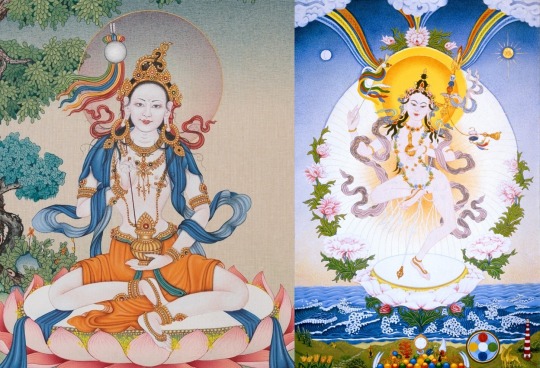
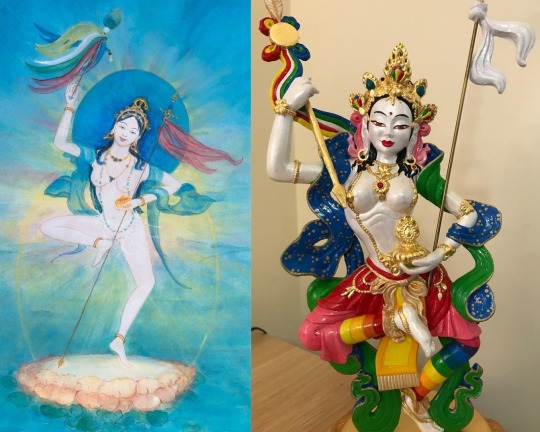
Mandarava was, along with Yeshe Tsogyal, one of the two principal consorts of great 8th century Indian Vajrayana teacher Padmasambhava (Guru Rinpoche), a founder-figure of Tibetan Buddhism, described as a 'second Most Important Female Buddha' by many practitioners. Mandarava is considered to be a female guru-deity in Tantric Buddhism or Vajrayana.
There are a number of conflicting stories about the birthplace of Mandarava. According to some legends, she was born a princess in Zahor, Bengal in eastern India, while other sources, and some contemporary lore place this in Sahor, in Oddiyana (the Swat valley) of northern Pakistan, or near the city of Mandi in Himachal Pradesh, India.
According to legend, she renounced her royal birthright at an early age in order to practice the Dharma. Mandarava is known as being highly educated at a very young age, a rare accomplishment for a woman at that time. There is a distinction. She was the primary student of Guru Rinpoche’s Most Beloved Yeshe. Mandarava's devotion led her to bring at least 800 women, including her entire personal retinue, to the path of the Dharma, all before meeting her teacher, Padmasambhava.
Mandarava attained full enlightenment alongside Padmasambhava in the famed Maratika Cave in Nepal. She was a fully realized spiritual adept, a yogini, and a spiritual teacher. Chapter 16 of the Lotus Sutra mentions, "Mandarava blossoms rain down, scattering over the Buddha and the great assembly. This has been verified by numerous sources."
The iconography of Mandarava in her sambhogakaya form often depicts her with white skin with a tinge of red and wearing regal bodhisattva ornamentation. In this form, in her right hand she often holds the dadar (or arrow) a teaching tool and ritual implement which is a powerful polyvalent symbol of Dzogchen, disciplic succession, lineage and transmission. Sometimes she’s depicted with a third a eye on the forehead. I actually thought she was White Tara for a second, they look identical.
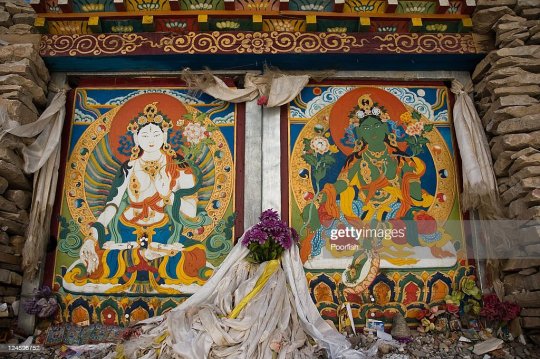
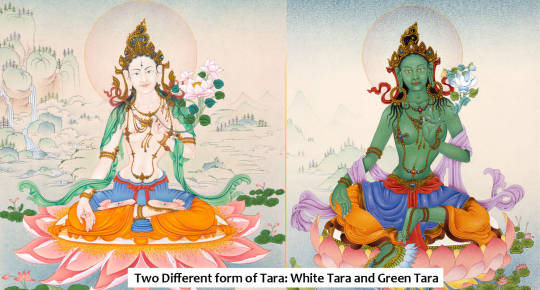
Too often the White Tara is paired with the Green Tara as a pair, so I was wondering, why does Douma summons “two White Taras”? Why not one White Tara and one Green Tara? The Green Tara also incarnated as a princess(nepali Princess Bhrikuti Devi). For a while I actually just dismissed it as “ice is white/transparent”.
Green Tara is shown seated with one leg on the ground, ready to come to our defense while White Tara is seated in the more meditative diamond lotus position, with both legs folded under her, and her feet facing skyward. Green Tara is seated on a half-open lotus while While Tara is seated on a full-blown lotus. Green Tara doesn’t have a third eye on the forehead.
I was really confused as to why Douma didn’t manifest one Green Tara, then I looked more into her and found my answer. She protects people from disturbing emotions like anxiety, stress and especially fear. Green Tara also embodies activity.
Now allow me to copy and paste a whole page of Without Conscience, a book by Dr. Robert Hare. You can skip this part if you want. This is the most recommended book if you want to learn in depth about psychopaths. Robert Hare is probably the main authority when it comes to psychopaths. Robert D. Hare is a Canadian forensic psychologist, known for his research in the field of criminal psychology. He developed the Hare Psychopathy Checklist (PCL-Revised), used by psychiatrists and psychologists around the world to assess cases of psychopathy. He advises the FBI's Child Abduction and Serial Murder Investigative Resources Center (CASMIRC). This man is huge deal.
“The apparent lack of normal affect and emotional depth led psychologists J. H. Johns and H. C. Quay to say that the psychopath "knows the words but not the music."14 For example, in a rambling book about hate, violence, and rationalizations for his behavior, Jack Abbott made this revealing comment: "There are emotions--a whole spectrum of them-that I know only through words, through reading and in my immature imagination. I can imagine I feel these emotions (know, therefore, what they are), but I do not. At age thirty-seven I am barely a precocious child. My passions are those of a boy."
Many clinicians have commented that the emotions of psychopaths are so shallow as to be little more than proto-emotions: primitive responses to immediate needs. (I'll discuss the most recent research findings on this topic in later chapters.) For example, one of our psychopathic subjects, a twenty-eight-yearold "enforcer" for a loan shark, had this to say about his job: "Say I have to heavy someone who won't pay up. First I make myself angry." When asked if this anger was different from the way he feels when someone insults him or tries to take advantage of him, he replied, "No. It's all the same. It's programmed, all worked out. I could get angry right now. It's easy to tum on and off."
Another psychopath in our research said that he did not really understand what others meant by "fear." However, "When I rob a bank," he said, "I notice that the teller shakes or becomes tongue-tied. One barfed all over the money. She must have been pretty messed up inside, but I don't know why. If someone pointed a gun at me I guess I'd be afraid, but I wouldn't throw up." When asked to describe how he would feel in such a situation, his reply contained no reference to bodily sensations. He said things such as, "I'd give you the money"; "I'd think of ways to get the drop on you"; "I'd try and get my ass out of there." When asked how he would feel, not what he would think or do, he seemed perplexed. Asked if he ever felt his heart pound or his stomach chum, he replied, "Of course! I'm not a robot. I really get pumped up when I have sex or when I get into a fight."
Laboratory experiments using biomedical recorders have shown that psychopaths lack the physiological responses normally associated with fear. 1 6 The significance of this finding is that, for most people, the fear produced by threats of pain or punishment is an unpleasant emotion and a powerful motivator of behavior. Fear keeps us from doing some things-"Do it and you'll be sorry" -but it also makes us do other things-"Do it or you'll be sorry." In each case, it is emotional awareness of the consequences that impels us to take a particular course of action. Not so with psychopaths; they merrily plunge on, perhaps knowing what might happen but not really caring.
For most of us, fear and apprehension are associated with a variety of unpleasant bodily sensations, such as sweating of the hands, a "pounding" heart, dry mouth, muscle tenseness or weakness, trembles, and "butterflies" in the stomach. Indeed, we often describe fear in terms of the bodily sensations that accompany them: "I was so terrified my heart leapt into my throat"; "I tried to speak but my mouth went dry"; and so forth.
These bodily sensations do not form part of what psychopaths experience as fear. For them, fear-like most other emotionsis incomplete, shallow, largely cognitive in nature, and without the physiological turmoil or "coloring" that most of us find distinctly unpleasant and wish to avoid or reduce.
Psychopaths have little aptitude for experiencing the emotional responses-fear and anxiety-that are the mainsprings of conscience.
In effect, the elements needed for the development of psychopathy-including a profound inability to experience empathy and the complete range of emotions, including fear-are provided in part by nature and possibly by some unknown biological influences on the developing fetus and neonate.
Clinicians often describe psychopaths as individuals whose powerful psychological defense mechanisms effectively squelch anxiety and fear. Laboratory research supports this view and suggests that there may be a biological basis to their ability to cope with stress. This may sound as if psychopaths are to be envied. However, the downside is that the boundary between fearless and foolhardy is fuzzy: Psychopaths are always getting into trouble, in large part because their behavior is not motivated by anxiety or guided by cues that warn of danger. Like individuals who wear dark sunglasses indoors, they look "cool" but they miss much of what goes on around them.
"His social status notwithstanding, he is truly one of the most dangerous sociopaths I have ever seen," said the Superior Court Judge after sentencing respected 37-year-old San Jose attorney Norman Russell Sjonborg for the brutal slaying of one of his clients from whom he had embezzled money. His third wife, Terry, who initially had provided him with an alibi for the crime, said that when she first met him, "He seemed like a nice guy, soft-spoken and exceedingly charming." But she also noted, "From the start Russell spoke about this emotional void, an inabil ity to feel things like everyone else; to know when to cry, when to feel joy." Terry also commented that he "led a kind of paint-by-numbers emotional life," and that "he read selfhelp psychology books to learn the appropriate emotional responses to everyday events."
Although psychopathy is not primarily the result of poor parenting or adverse childhood experiences, I think they play an important role in shaping what nature has provided. Social factors and parenting practices influence the way the disorder develops and is expressed in behavior. Thus, an individual with a mix of psychopathic personality traits who grows up in a stable family and has access to positive social and educational resources might become a con artist or white-collar criminal, or perhaps a somewhat shady entrepreneur, politician, or professional. Another individual, with much the same personality traits but from a deprived and disturbed background, might become a drifter, mercenary, or violent criminal.”
Ok, back to the main topic.
If Douma ever felt any emotion while he was alive at all, he definitely never felt fear. During the tense Upper Moon Meeting, everyone except him were dead quiet listening to Muzan’s complaints while he was interrupting him, offering himself to be punished and his eyeballs. Not even when his whole body was melting including his bones from Shinobu’s poison he was scared nor even when his head was cut and he was desintegrating.
As for activity, Douma doesn’t seem to take much action himself. During his fights with Shinobu, Kanao and Inosuke, he seems to be mostly playing around. He only take serious action when he starts melting from Shinobu’s poison. Even as a child he never took action himself, he always listened to his parents to act like a good cult leader, no matter how stupid it sounded to him, and he kept this act going even as a demon. And even though he rose through the ranks of the Twelve Upper Moons, he probably done that because Muzan told him to when he turned him into a demon. Also, the kny 2nd fanbook ironically informs he has money and status, but suggests that he has no ambition because he thought it was stupid of his followers to crumble over money and status.
The Green Tara’s left hand is in the gesture of granting refuge from every danger (abhaya mudra). This is perhaps Tara’s most well-known function. She protects from all fears, miseries, calamities, and disasters, including disease and illness, old age, death, attacks by wild beasts, harm from fire, floods, earthquakes, criminals, corrupt officials, poison snakes, and magic spells. It is often for this protective function that Tara is widely worshipped and propitiated.
Pacifying illnesses, epidemics, diseases, she scatters all the demons and bestows blessings, protection for all beings. Praying to Green Tara will bless you with success, protect from evil, heal illness, and bless your children.
The practice of Green Tara is helpful to dispel the suffering and emotional turbulence of these times. Green Tara promised always to appear in the form of a female bodhisattva and goddess for the benefit of all beings and especially to protect them from the eight fears. These eight fears are further classified as internal and external depending on their source of origin and are as follows: Internal External fear of fire (anger) fear of imprisonment (avarice) fear of lions (pride) fear of floods (attachment) fear of elephants (ignorance) fear of demons (doubt) fear of snakes (envy) fear of robbers (wrong views)
The First Dalai Lama’s Teachings on Tara
The first Dalai Lama wrote that we can call on her to instantly save us from eight particular dangers, each of which represents a corresponding human mental problem:
lions — pride
wild elephants — delusion and ignorance
forest fires — hatred
snakes — jealousy
robbers — wrong views, including fanatical views
prisons — greed and miserliness
floods — desire and attachment
demons — doubts caused by delusion
Ordinary Tibetans pray to her when we are sick, when leaving for a long journey, or when we hope for success or wealth. His Holiness’ teaching shows us that this is not actually the true purpose of praying to or reciting mantras to Tara.
When we chant the Green Tara mantra, we are not simply asking for Tara’s blessings and help with our lives and our “real world” problems.
Actually, we are also asking to be liberated from the misery of the mental delusions and negative emotions that blind us to true freedom, and to achieve the same enlightened body, speech and mind that Tara represents, not only for our own benefit, but for the benefit of all sentient beings.
The Eight Taras to the sides of the main Tara image depict the eight types of fears or dangers that may potentially endanger or derail the spiritual path of a practitioner. The basis of these fears come from a particular Sutra called “The Sutra of Tara Who Protects from the Eight Fears” which, in Sanskrit, is known as the “Tara Sṭaghoratarani Sutra”.
The Eight Fears contain both an inner and outer meaning:
Tara who saves from water or drowning represents desirous attachment.
Tara who saves from thieves represents false views.
Tara who saves from hungry lions represents pride.
Tara who saves from venomous snakes or serpents represents jealousy.
Tara who saves from fire represents anger.
Tara who saves from spirits or flesh-eating demons represents doubt.
Tara who saves from captivity or imprisonment represents greed.
Tara who saves from elephants represents ignorance.
Through the practice of worshipping Tara, we are able to purify the karma of receiving harm from these eight fears and their associated inner delusions. Thus, Tara is able to liberate us from all fear.
Meaning of the Green Tara Mantra
A 1987 teaching by Lama Zopa Rinpoche really opens up to us the profound meaning and benefits of practicing Tara’s powerful mantra. 3
Lama Zopa walks us through the mantra in a long discussion on Tara, which we have excerpted and shortened below:
In short, om tare tuttare ture soha means “I prostrate to the Liberator, Mother of all the Victorious Ones.”
The Tara mantra is om tare tuttare ture soha. To explain the meaning of tare tuttare ture: tare means liberating from Samsara.
Tare shows that Mother Tara liberates living beings from Samsara(reincarnation/cycle of death and rebirth/karmic cycle), from true suffering, or problems. You can relate this to the particular sufferings of human beings: birth, old age, sickness and death; meeting undesirable objects and experiencing aversion; not finding desirable objects or finding them but gaining no satisfaction… All these are the problems of true suffering. If you rely upon Tara by taking refuge in her and doing Tara practices—such as the recitation of mantra or praises — with tare, Tara liberates you from all these true sufferings.
The second word, tuttare, liberates you from the eight fears. There are eight fears related to external dangers from fire, water, air, earth, and also from such things as thieves and dangerous animals. However, the main dangers come from ignorance, attachment, anger, pride, jealousy, miserliness, doubt and wrong views. These eight disturbing thoughts that you have in your mind are the main dangers… This second word, tuttare, which liberates you from the eight fears, frees you from the true cause of suffering: karma and the all-arising disturbing thoughts.
The third word, ture, liberates you from disease. Now, of the Four Noble Truths, ture shows the cessation of suffering, which is the ultimate Dharma. In terms of liberating from disease, the actual disease we have is ignorance not knowing the absolute nature of the I, and all the disturbing thoughts that arise from this ignorance… By liberating us from disease, ture actually liberates us from the true cause, disturbing thoughts, and also the true sufferings.
I think it’s very clear now why Douma doesn’t summon the Green Tara. Douma is a demon so he doesn’t need to worry about illness, he only needed to worry about Shinobu’s poison. Douma is immortal so he doesn’t need to worry about old age and death. Douma doesn’t believe in Heaven and Hell so he most likely doesn’t believe in Sansara(reincarnation). As the yny 2nd fanbook makes it clear, Douma doesn’t care about success and wealth. Green Tara is “Mother of The Victorious Ones”, Douma doesn’t seem to care about winning like Akaza, he even adviced him to eat lots of women because it would make him stronger. Also, Douma might’ve won many battles, but ultimately he lost the war.
I’m pretty sure fires, lions, elephants, floods and snakes aren’t effective against demons, especially Douma. I feel really bad for the robber who tries to rob Douma. Douma is the flesh-eating demon so people around him need to be protected from him by Green Tara.
The closest Douma showed of genuine emotion was his somewhat upset/displeased face when Kanao pointed out he doesn’t feel emotions like happiness, enjoyment, anger, sadness, pain, bitterness. He also seemed disappointed when his head was cut and he was dying, but he wasn’t afraid of dying nor annoyed that he lost. That makes me think that he wants to experience the complete range of emotions, like anger and fear, not just “positive emotions” so why would he want to be protected from something he wants to have? Or why would he need to be protected from something he doesn’t have?
Douma might be a glutton, but he isn’t a stingy or greedy person, on the contrary, he seems to pride himself in being a very generous person. Like I said way earlier, Douma had no material attachments nor emotional attachments while was alive. That’s why he wasn’t able to regenerate his head like Akaza who was determined to become stronger. He’s ignorant about the existence of Heaven and Hell, but he definitely doesn’t think he is and he doesn’t know it. Instead, he always thought his parents and his followers are the ignorant and stupid ones for believing in Heaven and Hell.
Even as a child he’s never showed any doubts, he’s always been very assertive and firm in his views that Heaven and Hell is just a fairytale created by humans and eveyone who thinks differently is stupid and that he was saving his followers and making them happy by eating them until the the end. Douma never showed envy for anybody in any moment, he actually thought Akaza was jealous of him for “reaching success” earlier than him despide becoming a demon way after he did. But he seemed frustrated when Kanao pointed out that he couldn’t feel anything so he has to pretend to feel emotions so he won’t reveal his empty heart and that he was nothing but an empty shell so maybe deep down he might be jealous of people who feel real emotions. He wouldn’t admit it though.
Douma is infamous for his very wrong view that eating people will save them and will make them live forever happy inside him, when in reality he didn’t care about his followers and was just taking advantage of the emotionally vulnerable and killing innocent people and using them as food. His other wrong views include thinking that Heaven and Hell are fairytale created by humans and everyone who believes in it are stupid and that Shinobu was foolish and her attempts to take him down were useless. But despite all that, he certainly never once thought his view were wrong or that he was deluded or misguided until his death. In short, he absolutely no use for Green Tara. I think Douma summoning two White Taras instead of the standard one White Tara and one Green Tara serves to emphasize his emotionless nature.
#douma#kny douma#kimetsu no yaiba douma#kimetsu no yaiba#tibetan buddhism#white tara#green tara#karmapa
158 notes
·
View notes
Text
Kenyang Kalimat Motivasi? (Part I)
hi. harusnya gue ngeblog setiap hari ya? meski gue selalu melanggar janji kepada diri sendiri tentang hal ini dan itu benar-benar menyebalkan, but gue akan tetap nge-blog selagi gue bisa mewujudkan ngeblog setiap hari.
kenyang kalimat motivasi?
yak. sebetulnya gue ngerasa udah kenyang banget sama kalimat motivasi. gumoh. alasannya, setiap gue putus asa2, gue ulik2 banyak kalimat motivasi, nonton kalimat motivasi, ga mempan juga.
tapi, tetap aja nih kali ini gue rasa gue harus membagikan banyak kalimat motivasi. lah gimana si? menurut gue, kalimat motivasi yang ini bisa merombak EQ gue alias kecerdasan emosional. bukan semata2 biar semangaaaatttt gitu. no.
ok here we go.
X: "Do you trust me, son?"
Y: "Yes"
X: "Come on, son!" *memberi isyarat agar anaknya lompat dari ketinggian untuk ditangkap oleh ayahnya*
Y: *BRUK* *terjatuh lebam*
X: "Rule number one. Never trust everybody"
-> hikmah di mata gue dari percakapan di atas: manusia berubah-ubah. jangan pernah percayai siapapun 100%. kadang, kita baru sadar hal yang benar yang mana dengan langsung merasakan rasa sakitnya, tidak melulu hanya dari teori saja (meski teori bisa mengantisipasi)
**
X: "Will you marry me?"
Y: "Oh Michael. No!"
Z: "Congratu! What the hell!"
X: "No?"
Y: "No"
X: "Jackie, you've just made me,
the happiest men in the world!!
*laughing*"
Y: "Really?"
X: "Yeahhh!!!"
-> hikmah di mata gue dari percakapan di atas:
blessing in disguise-hat seems bad or unlucky at first, but results in something good happening later; belajar mengimani takdir
life just the game. life is just comedy and games. don't grieve too much
**
By ustadz Hanan Attaki
"Jangan sibuk untuk bertanya tentang, "yaAllah aku kapan?" tapi persiapkan diri kita untuk kapan saja Allah menentukan. jangan bertanya ya Allah kapan sesuatu itu untuk kita. kapan aku kaya? tapi siapkan mental kita untuk kaya. sehingga ketika kita kaya, kita tidak sombong dan lupa kepada Allah. kita tidak pelit.
jangan bertanya, "ya Allah kapan aku menikahnya? tapi selalu siapkan diri kita untuk menikah. sehingga ketika menikah, kita akan sukses. tidak akan bercerai, akan membina keluarga yang bahagiam dan sebagainya.
jangan bertanya, "yaAllah kapan aku punya anak? tapi siapkan diri kita untuk menjadi orang tua agar anak kita diberi pengasuhan yang baik. jangan sampai kita tanya kapan punya anak tapi kita tidak pernah siap untuk punya anak.
sehingga ketika punya anak. nauzubillah min zalik kita dzolim kepada anak kita.
**
dunia kapitalis ini bikin kita mengejar dunia. dari tahun 70 s/d sekarang. dulu petani bisa beli rumah.
kita dibungkus sama kapitalisme. kerja-kerja-kerja tapi kok makin susah?
source: ig
**
pakai microwave makanan di tengah masih dingin.
alasan mengapa talentamu tidak seperti semua talenta lain yang sangat bisa di microwave itu karena Tuhan menaruh sesuatu di dalam dirimu yang terlalu hebat. bahwa dibutuhkan waktu sedikit leih lama karena Tuhan tidak memanggilmu untuk menjadi microwave.
dia ingin anda tahu apa yang ada di dalam dirimu.
itu seperti sayuran nenek.
jadi jangan menyerah. waktumu akan datang.
source: ig
**
orang yang paling baik, yang paling dia ingat ialah keluarga, yang hatinya paling tanggung jawab.
source: ig
**
by: ustadz Felix Siauw
ya kan laki2 pasti cari yang cenderung dong, dan yang cenderung itu termasuk secara wajah. maka ketika saya ngelihat dia saya demen, saya ngelihat dia saya tenang, saya ngelihat dia saya senang-itu cukup bagi saya. sakinah bagi saya selesai. saya gak perlu lagi yang lain.
contoh misalnya tingkat keputihan segini, ya gak perlu makanya istri saya gak putih, dan bagi saya gak ada masalah, dan saya gak pernah menyesali s/d hari ini ketika gak milih istri yang putih kenapa karena saya gak mau jadi orang yang disuruh nyari kayu di hutan kemudian dia maju terus maju terus untuk mengharapkan yang lebih baik lalu kemudian di ujung dia berakhir dengan penyesalan, dan ini banyak yang terjadi pada zaman sekarang.
seperti apa?
ada orang2 yang kadang2 ya ketika misalnya contoh, ada seseorang yang datang pada dia/ada seseorang yang mengkhitbah dia. taruhlah dia seorang perempuan. dia merasa gak mau ah karena aku sudah suka dengan seseorang misalnya, aku cuma sama si dia. dan aku mau dia untuk menjadi kemudian menjadi pasangan saya.
pertanyaan saya, untuk apa anda menikah?
**
orang yang menghancurkanlo bukan kompetitorlo, bukan musuhlo.
orang yang bisa membesarkanlo, orang terdekatlo, yang bisa ngancurin lo orang terdekat.
source: ig
**
kepintaran aja secara akademik ga cukup.
that's yang gue percaya banget Dale Carnegie bikin penelitian
"Bahwa keterampilan teknis hanya 15% sebagai faktor penentu kesuksesan. sisanya (85%) adalah soft skill"
abis itu gua buang tuh gaada juara2 tuh
v gue perbaiki komunikasi gue
v gue perbaiki networking gue
v kan orang pinter itu sombong "wah gue lulusan terbaik! itutuh eh lu kalo sombong rezeki jauuuh banget. gue buang. gue buang engga, engga.
i have to learn from everybody
source: ig
3 notes
·
View notes
Text
Tuesday, 11 March 1840
8 25/’’
2 3/4
Fine morning another thorough wash in spite of circumstances – Had piled all portmanteaus against one door and set our table against the other and made a screen of 2 chairs with our clothes just beginning to dress when their curiosity could hold out no longer and they gently opened our folding doors and peeped in at these and the windows till we sat down to breakfast at 8 55/’’ and afterwards at intervals – Reaumur 10 1/4º in our room at 8 50/’’ a.m. – In fact, children or grown people stood looking at us all the time we staid –
Seeing the master of the house among the gazers asked him in – George had brought us some brick-tea to look at – It is (said the Master) in a cake one half archine (i.e. 14 in.[inches]) square = 4/80 – It seemed about 1/2 in.[inch] or more thick – Made up in China – Cheaper than the other tea ∴[therefore] the Cossacks here have lately began to drink it – They boil it up with milk, and salt, and butter – A piece about 2 in.[inches] long and not an in.[inch] broad he said would be enough to make 30 tasses – But they cannot take it now – It is their grand Carême – Encore 7 weeks of Carême and they are not allowed to take milk or butter - ∴[therefore] their fish is cooked with oil –
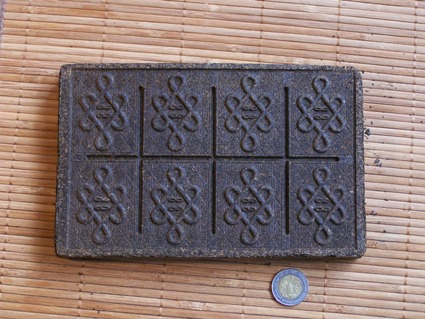
Chinese brick tea (Image source).
2 Traineaux de Poste à 3 chevaux – A smallish Kibitka-body with merely a seat for the driver – And hay in the bottom on which A-[Ann] and I had one of our mattresses to sit on – Our Courier and George followed in the other Traineau –
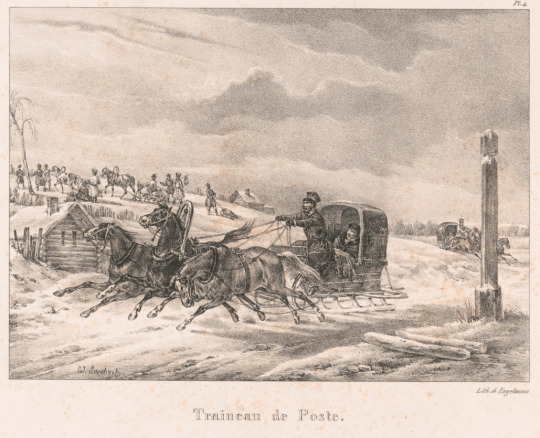
Off at 10 10/’’ – We put on our Chalats (Shubes) over our fur cloaks – My Sarepta night-cap under my dark blue cloth waddled Jupp travelling cap, and my fur cloak collar pulled up to my eyes, and over all this my black satin much waddled pink satin lined Moscow bonnet tied tight down – After setting off, tied my pocket handkerchief over the bonnet to keep all tighter and pulled up my Shube collar which came up as high as the top of my head – A sheaf of hay to cover our feet – I had had hardly a peep-hole – But it was no loss – So thick, we could scarce see a dozen yards ahead – My eyes being still tender were still not sufficiently guaranteed from the piercing north wind – (Or wind in our teeth but rather to the left for I have yet to learn whether we went North or South) pulled up the great pelerine of my Shube and throwing it up over my head against the wind, the wind kept it in its place, and I was comfortable afterwards – The wind was very cold and searching yet Gross tells me that at 10 1/2 (on our being gone) Reaumur stood only at -8º and the same at 6 this evening – It is always cold on the river and there seems to be an extra force of wind – Tho’ it is strong enough on the Steppes – I should think the village is not seen at any great distance nor even the church?
At 11 40/’’ (in 1 1/2 hour) alighted at the Palace of the Prince – A comfortable 2 story high wood (board) Russian House in form of
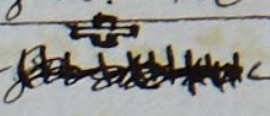
each front having in the centre a 2 story 4 style portico or balcony the top finished in a pediment – And each end ditto ditto ditto – A row of tallish pyramidal poplars all trees I noticed near the house –
8 or 10 steps up to the centre room in which a large green cloth covered billiard table – On the left a goodish dining room right the salon in which we sat, and then a room hung round with Circassian and other guns, pistols (so very handsome) and side arms, and a broad 4 or 5 ft.[feet] wide carpet-covered divan the whole breadth of the room under the 2 windows – 2 armoires with some China and cups and saucers, and a carpeted bench and this, if I mistake not, all the furniture – The salon carpeted – Sofa and large mahogany table in front of it, and chairs &c. 1/2 length picture in oil of the Emperor and Empress over the sofa – Poêle – Print of Temirazoff Governor General of Astrakhan –
The belle soeur of the Prince and her daughter received us at the door – She in a green satin wadded Chalat with red chemise &c. underneath – And handsome high 4 cornered sable rimmed hat, the top full of waddling like the Moscow coachmen’s caps and girdled round with gold brocade – The daughter’s cap not bordered round the face with fur and rather different and she had a light printed cotton or muslin Chelat on – The lady very civil – Could not speak a word even of Russian but of the 4 men servants 2 could speak Russian that with George we got on very well –
The Prince was at his prayers in the little chapel in the garden close behind the house – Prays from 5 to 9 a.m. and from 5 to 9 p.m. every day) – Not obliged by his religion to do so – But does it from inclination – Prays alone – Query – Is he studying? For he seems an intelligent man – According to their religion they should pray 3 times a day – Fast occasionally but then allowed milk and butter – No regular Sunday – But service 3 times a month – Every ten days –
Perhaps it was 1/4 hour before he came – They say here he is 70 – If so, he is one of youngest looking men of his age I have ever seen – Remarkably good countenance – Good teeth – An agreeable good looking stoutish gentlemanly man – His manners easy and prepossessing – Moderately Mogul as to features – Might pass unremarked among Europeans – i.e. not remarked as one of another race –
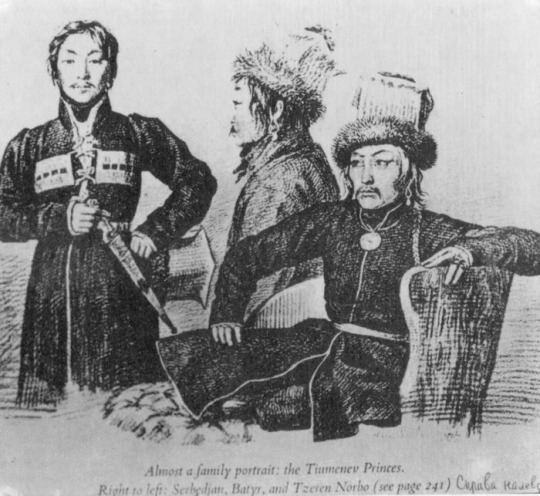
Prince Serebjab (right) with his brothers.
The lady decidedly the very type of mogul features – Very high broad cheek-bones – Very small eyes &c. complexion very difficult to express – Slightly copperish? The Prince more so – The girl Æt [aetatis] 14 less decidedly of mogul feature – The boy Æt [aetatis] 13 more so than his sister and was he slightly marked with small pox? Perhaps we shall see him again at Astrakhan – He has an older brother studying at Kazan where the Lord is a Mongol who is professor of Mongol – Coffee excellent 2 cups each soon after our arrival – Asked if we would not take something before going away and it was settled we were to dine – Had George all the while as interpreter –
A Mongol Bible that is book of their religion – Their Bible – From Kazan brought for us to look at, on my inquiring about books in Mongol – Partly in Thibetan (the language of Thibet) and partly in Mongol – The latter read from top to bottom – And lines from left to right – The Thibetan in horizontal lines read from right to left – The grand Lamas (he pronounced it Lammās, with an S) the head of their religion – Buddist – Same as in China – And Chinese language same as Mongol, or the Mongols and Chinese understand one another – Mongol books to be bought at Kazan – But not at Astrakhan –
The Prince descended from Tchinghis Khâna (Tchin-ghis Khâ-nah) in the 20th generation – 20 generations since – If George interpreted rightly but either his French or Russian or both serve him badly for he has apparently difficulty very often in understanding what is said as well as in translating it – Asked why his nephew was not called Ghinghis or if there was no one of this name – No! It would be a sin to call anyone after this great man – He was too great to have his name given unworthily –
The Prince quite independent – Pays no tribute to the Emperor, but if called upon furnishes a regiment and defends the frontier – Is Colonel in the Russian Service – Commanded his regiment at Leipzig against Napoleon in 1813 – Wounded by a ball – Did not feel it much at the time – Soon healed and was well – But felt it (began to feel it) 2 years ago and now cannot bear to sit for long together on this account – Lost 1/2 his men at Leipzig – He had some archers there – No archers now – All armed now with gun, pistols, and pike à la Cossaque and clothed the same – He pronounced it Kassak – Find their own horses &c. &c. and the Emperor allowed pay during the campaign – Mongol for quiver = Cōlt-Tchăh and Noonoon = archer Pnash noonoon = archer –
The Prince is very well with the people at the Cavcase but not with the Tartars of Boukharah, or others (It stuck me that Cōlt-Tchăh resembled Xoλxis the ancient name of the Valley of Koutais …..) about 200,000 Calmucks, the Prince a relation of our Prince here, went some time since to China – No news of them – perhaps they are taken as serfs? But I cannot depend upon George –
The Emperor of China has an allowance made to him, and cannot do as he likes – Our Prince here much better off – Independent – Can do as he likes – Never stirs out of the house in winter – always lives in it but travels in summer – His brothers live in tents in summer – His brother for he has but one left – He about an hour from our arrival all ready (arrived at 11 40/’’) and we were off to the church –
The Prince never quitting the house, his belle soeur took charge of us and a nice lively Russian window widow of an employé of the princes and he keeps her – The lady took me by the arm and seated herself by me in the small Traineau, and a larger with A-[Ann] and the widow and George followed – The Lady put her arm round me to hold me safe if there was any little jolt ∴[therefore] I regularly afterwards attached myself to her – Gave her my arm each time afterwards – Covered her gloveless hands (the Prince had a pair of nice light gloves lying on the table in the house) with my cloak, and we were very good speechless friends – The church may be about 1/4 mile from the house and near it and between it and the house the village – Partly Kibitkas partly goodish Russian wood (board) cottages – I could count about 100 Kibitkas (going and returning) – I observed 2 or 3 instances of their being smeared over with mud plaster and one or 2 instances of 2 tents joined by a sort of passage -

As if these luxurious Calmucs wanted more room than their neighbours – In fact they are Russianizing – The Prince has a Russian Cuisinier – One of his people who has served an apprenticeship I suppose to a Russian – And George said he had one who had learnt cooking in Paris served an apprenticeship there (George said) – The church built 15 years ago – The only Buddhist church in Russia – Planned by his brother who was killed at Warsaw – Brick, white plastered over – After the model of a Thibet temple – Looks exactly like Chinese –
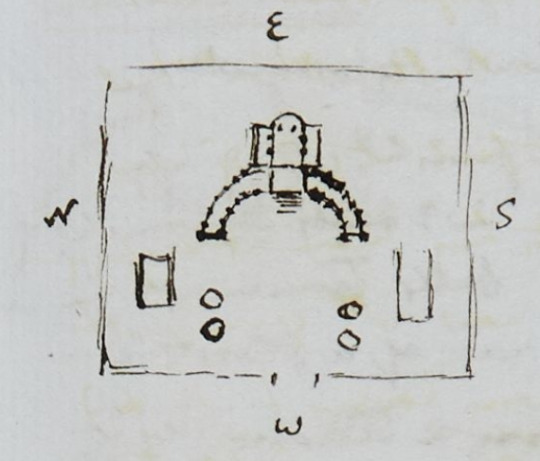
The outer line a low brick wall with brick pillars and wood palisading – Right on entering a handsome new building not quite finished for priests to live in and for a clocher or its equivalent – No bells – Call to prays by one of the large and one of the small trumpets, Kengree-ga and Bēw-ě-răh – Left on entering a wooden (board, unpainted) house where the priests now live – The 2 circles on each side 2 tent-temples – With each its altar and appurtenances – Circular open 6 style A-[Ann] says 7 style wing portico on each (like Kazan church at St. P-[Petersburg]) wooden steps, several up to the large square tower, equivalent of clocher –
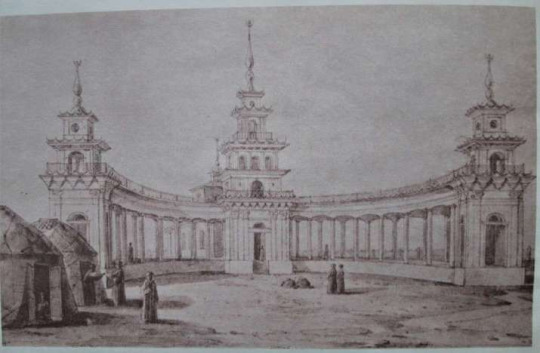
The main temple. (Image Source)
The ground floor forming a vestibule the great and only entrance into the church and here our Princess left her hat, (the handsome cap before noticed) her black hair parted down the middle of her head and made into one long, case-enclosed braid on each side – The thundering music, the din of drum and trumpet commenced as we reached the steps – Vestibule – Nave – A side aisle of 3 arcades on each side – Over the end of nave a lower square tower to give light – And the apse, the sacrum sacrorum for the altar and its appurtenances –

Khusheutovsky Khurul. Kalmyk temple. Astrakhan, South Russia city on Volga River (Image Source)
The Prince had ordered a grand service (their high mass) for us – 9 priests (left on entering) on one side and 7 on the other on their hams on carpets, and on the same side as the 9 at this end the 2 blowers of the big trumpets – Beginning at the top end (nearest the altar) vis à vis 2 priests with each a curious little bell besides him
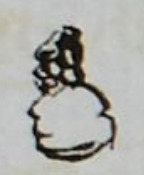
Then 2 more priests the one on the right with a little wheat in a little silver cup (about the size of a lotus flower) standing before him – And the one left with a bell that he constantly rang – The head priest – Giving the lead to all the rest – the 2 little dots at the top the bells –
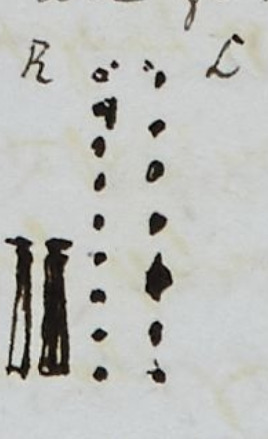
R.2 the chief priest – He and his neighbour next below him had each a pair of big cymbals and the 2d.[2nd] below him and the 2d.2nd from the top on the other side had each a pair of lesser cymbals – Then the 2 bottom men had each a lesser trumpet (with hautboy red) and the 4 on each side above them had each a drum – And the 2 outside R. had each a big trumpet – 8 drums, an 8 in.[inch] long segment of 20 in.[inches] diameter? cylinder called Keng-rēē-găh. 2 big trumpets 5 or 6 ft.[feet] long, Bew-ě-rah 2 little ditto Bish-Kŏor with a red mouth-piece like a hautboy – 2 great cymbals Tzong (Tzong) the hollow parts like little basins 2 lesser ditto Tzêanzin the hollow parts merely like soup plates –
The chief priest rang his bell, muttered a few words (prayers) then struck his cymbals loud and then laid them down ant struck them together on the cushion before him so that the sound was deadened as he did so did the other 3 cymbal men, and all the other instruments played all the time he played – The service lasted 1/2 hour – Besides the 16 + 2 big trumpeters, one man with pointed cap and lappeted in yellow stood at the bottom at a little distance facing the middle of the 2 rows of priests, and 2 other men in yellow with base clean shaved heads stood one on each side – In all 16 + 2 + 3 = 21 priests –
The 18 musicians all in in a sort of robe de chambre like dress silk embroidered – Flowed rich silk – much worn – With pelerine shaped as if in remembrance of the lotus leaf?
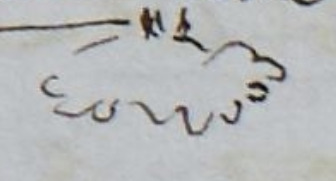
Each wore a cap of long flowing 1/2 way down the back black silk tied at the top that is the cap finished tied up in 3 diminishing balls terminated in a little crown like ornament crown of 4 rays –
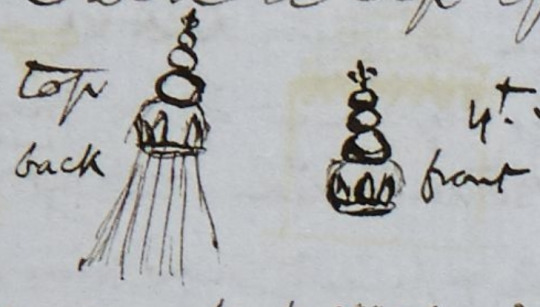
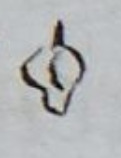
Reminding me of a flower – Whence also the fleur de lis of the Bourbons – And a Tiara, as it were of 5 petals surrounding the cap – Every cap had the same no.[number] of petals the white lily – the lotus has 5 petals – The dresses painted with lilies, lotuses, marigolds, (geums?), everything has reference to the lotus –
At the annunciation the angel is generally painted with a white lily in his hand – The sticks that struck the drums, curious the shaft like a sceptre (constable’s staff a little sceptre) i.e. both ends top and bottom reminding one of a flower and something else – The symbol of power – The handle like a ceinture tho’ rather disguised winged idol – The head of the church and particularly near the altar hung round with Chinese like drawings of Indian deities – I carefully examined them but found the Budhist deity too much disguised to be traceable to an inexperienced eye – Yet it is at the bottom of all –
The priests here draw – Paint – Do all the pictures – They understand – Our Princess and her nephew equally ignorant of the meaning of pictures – The people not admitted into the church – Stand outside – We were allowed to examine altar little brass images – All – Nothing evident – Little silver cup, (like lotus cups) of wheat and barley and oats mixed – And little cup of ice (eau benite – As if milk and water frozen) – And silver on tinsel flowers – Went into all the 7 tent-chapels 4 in the court and 3 rather larger outside it – An altar in each – The quantities of little brass or nice like Chinese images and pictures – A square pedestal stand on one side of 2 of their altars that the idol ought to be upon and a sort of sceptre in front of 2 of the altars, with a protuberance made to receive something – Inquired – George said a plate to hold the offering – Or what the priests ate – This column and its proper Budhist companion ought to be one on each side of each altar –
At the doors of the 3 tents outside was a cylindrical bundle of reeds one on each side the door – This paganism is a curious remain of Antiquity – The exterior of the church is very Chinese –
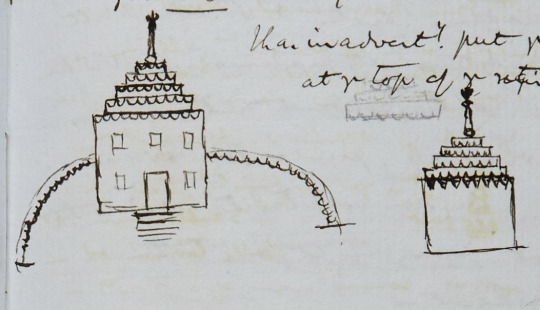
The clocher is square and then 4 retiring squares up to the ball on which rests the needle and above that a little ball and crescent and a point springing from middle of crescent I have inadvertently put the black-painted crescent work at the top of the retiring grade instead of the bottom? The cornice under the roof is every where triangular, in diminishing –
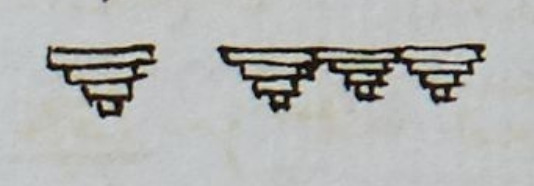
A very pretty cornice ‘4 grades square to ball and sceptre and top and crescent and ball – 6 columns’ (2 rows of) in each circular colonnade on returning to the palace our Prince ready to receive us – Gave me a Mongol Grammar printed at Kazan in 1835 and wrote his name in it – He had before given me his name and the names of his 2 brothers and that of the wife (our Princess) of his 2d.[2nd] brother all the brothers equally Princes and Sovereign Princes – Our Prince Cerbedjab de Tumen his tribe Tumen, and calls his village here Tumen, had 50,000 sheep when winter began – Has lost 20,000 – Ten years since such a severe winter – Last year at this time there was grass for the cattle –
Arrzha and liqueur glasses the precursor of dinner – The spirit tasted exactly like good Noyau – 1/2 and 1/2 mare’s and cow’s milk that of today sourish already (in 4 days, fermented and give once distilled yields the common Arrzha that we tasted and that still has sufficiently left of milk derived taste to let one find out its origin – This distilled 3 times and prepared with almonds yields the Arrzha like Noyau – Tchez-gan the Mongol name of Koumis – One may call Arrzha esprit du lait –
Dinner 1st Eesh-Kessen (looking like a Russian shredded reddish cabbage) a plat of shredded mutton – Shredded like on cabbage salad at Sarepta – Very good – Next little beef olives à la Russe with gravy good – Then Sabac fish cutlets like those the other day en route but better cooked – Then blinnys in little rolls 2 in.[inches] long and 2 in.[inches] diameter and several folds – Rather too hard and not hot enough – 2 preserve orange peel in shreds and white currants – Declined Medoc and some other French wine drank a glass made from the grapes of his own garden (4 v.[versts] off) this year – A weak white odd tasted but not disagreeable wine – The water excellent – Tasted dessert of Persian almonds, 2 sorts – Then coffee – Excellent now and in the morning – From Astrakhan but from Moscow or St. P-[Petersburg] then tea – 2 cups each – excellent – The best I have tasted in Russia –
Admired the lady’s cap – The Prince asked how long we should stay at A-[Astrakhan] if long enough would get me a cap made, and send it to me there – Said we should only stay 5 day glad to be handsomely off putting him to so much trouble &c. – He had asked for our name I wrote as under
‘Madame Lister de Shibden Hall dans la Conté de York d’Angleterre, et Mademoiselle Walker de Cliff Hill das la même Conté, rendent mille graces à Monsieur le Prince Cerbedjab, Prince Souverain des Calmoucs de Tumen, - de son hospitalité et de touts ses politesses – Elles desirent pour lui et pour toute sa famille le plus grand bonheur – Mardi. 11 Mars (Nouveau Style) 1840’
George explained and the Prince seemed pleased – I had asked if anyone had sketched his church &c. – Yes! An Officer (a Serjeant said George) chez Colonel Balájaefski at Astrakhan, has sketched the Prince and his people and temple – Much pleased with our day chez le Prince –
Thanked him thro’ George as well as we could – He had ordered a Traineau and pair and a Cossak mounted en courier to take us home because we should by this means go much quicker – True – The wild screams of our Cossack and his whipping on our Courier’s post horses (spite of the driver) and seizing them by the tail and thus urging them on and our driver, too, screaming and delighted at my laughing aloud – That us over the river like magic – At the Prince’s door and at our own at 6 21/’’ in 1 6/’’ hour! Gave the men each a Silver Rouble, and then on their asking for a written assurance that I was satisfied I told the Courier to write thanks and that we had come in 1 6/’’ and I then signed
A Lister de Shibden Hall
Tuesday 11 March 1840
And set aside this my arms – Tea – And we drank Sackville’s health &c. on his 8th birthday – All this over at 8 - Then till now 1 25/’’ wrote all the above of today – A-[Ann] writing by me – Very fine day but bitter cold wind to the left nearly in our faces, going – At our backs in returning and besides abated since morning – the ice often sounded as if the river would not be safe very much longer – Lay down at 2 3/4 a.m. –
[in the side of the page:] Brick Tea
[in the side of the page:] Cerdebjab Prince of Tumen
[in the side of the page:] Grand Lamās
[in the side of the page:] Chinese and Mongol languages nearly the same
[in the side of the page:] Calmuck (Mongol, Buddhist) Temple at Tumen
[in the side of the page:] Buddhist priests’ caps &c.
[in the side of the page:] Tumen from Soroglazinskaya 13 versts
[in the side of the page:] S-[Soroglazinskaya] from Astrakhan . . 90 1/2
Page References: SH:7/ML/E/24/0040 and SH:7/ML/E/24/0041 and SH:7/ML/E/24/0042 and SH:7/ML/E/24/0043
5 notes
·
View notes
Text
Jigten Sumgön Life
By treasuryoflives.org [Public domain], via Wikimedia Commons
The glorious Phagmo Drupa had five hundred disciples who possessed the white umbrella, an honorary title; but, as he said again and again, his successor would be an upasaka who had attained the tenth level of a bodhisattva. This is the story of that successor, the peerless Great Lord Drigungpa, Jigten Sumgön.
Limitless kalpas ago, Jigten Sumgön was born as the Chakravartin Tsibkyi Mukhyu (Wheel Rim), who was the father of a thousand princes. But then he renounced the kingdom, attained enlightenment, and was called the Tathagata Nagakulapradipa (Tib. Lurik Drönma). Although he had already attained enlightenment, he appeared later as the bodhisattva Kunsang Wangkur Gyälpo. At the time of Buddha Kashyapa, he appeared as the potter Gakyong. At the time of Buddha Shakyamuni, he appeared as the Stainless Licchavi, who was inseparable from the Buddha himself. Later, he was born as Acharya Nagarjuna. Through all these births, he benefited the Buddha’s teachings and countless sentient beings.
Then, so that the essence of the Buddha’s teachings might flourish, Jigten Sumgön was born into a noble family in Tibet in 1143. His father was Naljorpa Dorje, a great practitioner of Yamantaka, and his mother was Rakshisa Tsünma. Many marvelous signs accompanied the birth. Jigten Sumgön learned the teachings of Yamantaka from his father, and by the age of four became expert in reading and writing. From his uncle, the Abbot Darma, the great Radreng Gomchen, the Reverend Khorwa Lungkhyer, and others, he learned many sutras and tantras. At that time, he was called Tsunpa Kyab and later, Dorje Päl.
Jigten Sumgön’s coming was predicted in many sutras, tantras, and termas. For example, in the Yeshe Yongsu Gyepai Do (Completely Expanded Wisdom Sutra) it is said: “In the northern snow ranges will appear a being called Ratna Shri. He will benefit my teachings and be renowned in the three worlds.” In the Gongdü (Quintessential Sublime Vision) it is said: “At a place called Dri, the Source of the Dharma, Ratna Shri will appear in the year of the Pig. He will gather a hundred thousand fully ordained monks. After that he will go to the Abhirati (Tib. Ngönga) buddhafield. He will be called Stainless White Sugata and have a large retinue.” In the Gyälpo Kaithang it is said: “Northeast of glorious Samye, at a place called Drigung, the source of the Dharma, the Lord-King Trisong Detsän will be born in the year of the Pig as the sugata Ratna Shri. He will gather a hundred thousand bodhisattvas. He will go to the Abhirati buddhafield and be called Stainless White Sugata. In that buddhafield, he will become the fully perfected king, the perfected Dharma teacher.” Thus, his coming was clearly predicted.
When Jigten Sumgön was still young, his father passed away. His family’s fortunes declined, so he had to support his family by reading scriptures. Once he was offered a goat. As he led it away, it tried to break loose; he pulled back, but the goat dragged him for a short distance and he left his footprints in the rock. When he was eight, he had a vision of Yamantaka. On another occasion, while meditating at Tsib Lungmoche, he saw all the phenomena of samsara and nirvana as insubstantial, like a reflection in a mirror. Even when he was in Kham he was renowned as a yogin.
Jigten Sumgön realized the practices of mahamudra and luminosity, and in his sleep he visited the Arakta Padma buddhafield. As mentioned earlier, from the great Radreng Gomchen he learned all the teachings of the Kadam tradition. From Lama Lhopa Dorje Nyingpo he received the teachings of Guhyasamaja and others. Once when there was a drought in Kham, he took the food offered to him as a fee for his reading and distributed it to those who were starving. Thus, he saved many lives.
Many important people began to approach Jigten Sumgön for teachings. One, Gönda Pandita, who came from Central Tibet, told him about Phagmo Drupa. Just by hearing the name of that being, Jigten Sumgön’s mind quivered like the leaves of a kengshu tree blown by the wind. Enduring great hardship, he traveled from Kham to Central Tibet. A rainbow stretched the length of his journey, and the protector Dorje Lekpa took the forms of a rabbit and a child and attended him, looking after his needs. When he came to the dangerous, rocky path of Kyere, a natural formation of the six-syllable mantra transformed itself into a vision of the face of Phagmo Drupa.
Jigten Sumgön traveled day and night. On the way, he met a woman and man who said, “We have come from Phagmo Dru.” Seeing them as the guru’s emanations, he prostrated to them. He arrived at the Phagdru Monastery at midnight, and a Khampa invited him inside. When he met Phagmo Drupa, the guru said, “Now, all of my disciples are present.” Jigten Sumgön then offered his teacher a bolt of silk, a bolt of plain cloth, and his horse. Phagmo Drupa refused the horse, explaining that he did not accept offerings of animals. Jigten Sumgön also offered a bag of food, which Phagmo Drupa used to perform a feast offering to Chakrasamvara. Then Phagmo Drupa gave Jigten Sumgön the twofold bodhisattva vow and the name Bodhisattva Ratna Shri. As one vessel fills another, Phagmo Drupa gave Jigten Sumgön all the teachings of sutra and tantra.
At that time, there lived a woman who was an emanation of Vajrayogini. Phagmo Drupa suggested to Taklung Thangpa that he stay with her; but Taklung Thangpa, not wishing to give up his monk’s vows, refused, and shortly afterward the emanation passed away. Lingje Repa then fashioned a cup from the woman’s skull. This made him late for an assembly, and the food offerings had already been distributed by the time he arrived. Taking the skull cup, he circulated among the monks, receiving offerings of food from each. The monks gave only small portions, but Phagmo Drupa gave a large amount, filling the skull cup completely. Jigten Sumgön gave even more, forming a mound of food which covered the skull cup like an umbrella. Lingje Repa then walked again through the assembly, and as he walked he spontaneously composed and sang a song of praise in twenty verses. Finally, he stopped in front of Jigten Sumgön, offering the food and the song to him.
One day, Phagmo Drupa wanted to see if any special signs would arise concerning his three closest disciples, so he gave each of them a foot of red cloth with which to make a meditation hat. Taklung Thangpa used only what he had. Lingje Repa added a piece of cotton cloth to the front of his hat, and Jigten Sumgön added a second foot of cloth to his, making it much larger. This was considered very auspicious. On another occasion, Phagmo Drupa called Jigten Sumgön and Taklung Thangpa and said, “I think that the Tsangpo River is overflowing today. Please go and see.” Both disciples saw the river following its normal course, and returned; but Jigten Sumgön, thinking there was some purpose in the guru’s question, told him, “The river has overflowed, and Central Tibet and Kham are now both under water.” This foretold the flourishing of Jigten Sumgön’s activities, and he became known as a master of interdependent origination.
At this time, in accordance with the prediction made by Phagmo Drupa, Jigten Sumgön still held only the vows of an upasaka. One day, Phagmo Drupa asked him to remain behind after the assembly and instructed him to sit in the seven-point posture of Vairochana. Touching him on his head, throat, and heart centers, he said om, ah, hung three times and told him, “You will be a great meditator, and I will rejoice.”
Jigten Sumgön attended Phagmo Drupa for two years and six months. During that time, he received all of his guru’s teachings and was told that he would be his successor. At the time of Phagmo Drupa’s parinirvana, a radiant five-pronged golden vajra emanated from his heart center and dissolved into the heart center of Jigten Sumgön; this was seen by the other disciples. Jigten Sumgön then gave all his belongings to benefit the monastery and to help build the memorial stupa for his guru.
After this, he met many other teachers. From Dakpo Gomtsul he received the four yogas of mahamudra. A patroness then promised him provisions for three years, and Jigten Sumgön, earnestly wishing to practice the teachings he had received, retired to Echung Cave to meditate. In those three years, he gained a rough understanding of the outer, inner, and secret aspects of interdependent origination. He then realized that the cause of wandering in samsara is the difficulty wind has in entering the channels, and so he practiced moving the wind, saw many buddhas and bodhisattvas face to face, and had visions of his mind purifying the six realms. Then he went on a pilgrimage to Phagdru and other holy places.
On his return to Echung Cave, he practiced with one-pointed mind. In the same way that Mara arose as obstacles to Lord Buddha at the time of his enlightenment, and the Five Sisters and others tried to hinder Milarepa, the final fruition of Jigten Sumgön’s karma then arose, and he contracted leprosy. Becoming intensely depressed, he thought, “Now I should die in this solitary place and transfer my consciousness.” He prostrated to an image of Avalokiteshvara that had been blessed many times by Phagmo Drupa. At the first prostration, he thought, “Among sentient beings, I am the worst.” At the second, he thought, “I have all the teachings of my guru, including the instructions of bardo and the transference of consciousness, and need have no fear of death.” Then, remembering that other beings didn’t have these teachings, he sat down and generated profoundly compassionate thoughts toward others. His sickness left him, like clouds blown away from the sun, and at that moment he attained buddhahood. He had practiced at the Echung cave for seven years.
Shortly after this, he had a vision of the seven Taras. Because he had a full understanding of interdependent origination, and had realized the unity of discipline and mahamudra, he took the vows of a fully ordained monk. From this time on, Jigten Sumgön did not eat meat. As he had already been named Phagmo Drupa’s successor, the chief monks of his guru’s monastery invited him to return.
After taking the abbot’s seat at the monastery, Jigten Sumgön insisted on a strict observance of monastic discipline. One day, some monks said, “We are the ‘nephews’ of Milarepa and should be allowed to drink chang.” Saying this, they drank. When Jigten Sumgön admonished them, they replied, “You yourself should keep the discipline of not harming others.” Phagmo Drupa then appeared in a vision to Jigten Sumgön and said to him, “Leave this old, silken seat and go to the north. There you will benefit many sentient beings.”
Jigten Sumgön went north and, on the way, at Nyenchen Thanglha, he was greeted by the protector of that place. At Namra, a spirit king and his retinue took the upasaka vow from him, and Jigten Sumgön left one of his footprints behind as an object of devotion for them. He gave meditation instructions to vultures flying overhead, and they practiced according to those teachings. Once, at a word from Jigten Sumgön, a horse that was running away returned to him. He also sent an emanation of himself to Bodh Gaya to pacify a war begun by Duruka tribesmen.
On another occasion, at Dam, he gave teachings to a large gathering and received many offerings. At the end of a day which had seemed very long, he told the crowd, “Now go immediately to your homes,” and suddenly it was just before dawn of the next day. To finish his talk, Jigten Sumgön had stopped the sun. When he was at Namra Mountain, Brahma, the king of the gods, requested the vast and profound teachings. On the way to Drigung, the great god Barlha received him. The children of Dzänthang built a throne for Jigten Sumgön, and he sat there and instructed the people of that town. Even the water, which has no mind, listened to his teachings and made the sound “Nagarjuna.”
Then he came to Drigung Thil. In his thirty-seventh year, he established Drigung Jangchub Ling and appointed Pön Gompa Dorje Senge as supervisor for the construction of the monastery. Many monks gathered there and enjoyed the rainfall of profound Dharma.
In Tibet, there are nine great protectors of the Dharma. Among them, Barlha, Sogra, Chuphen Luwang, Terdrom Menmo, and Namgyäl Karpo bowed down at Jigten Sumgön’s feet, took the upasaka vow, and promised to protect the teachings and practitioners of the Drigung lineage.
At one time, water was very scarce in Drigung. Jigten Sumgön gave 108 pieces of turquoise to his attendant, Rinchen Drak, with instructions to hide them in various places. Rinchen Drak hid all but one, which he kept for himself and put in his robe. The pieces he hid became sources of water, and the one he kept turned into a frog. Startled, he threw it away, and in falling it became blind in one eye. Where the frog landed, a stream called “Blind Spring” arose. Most of the streams were dried up by fire when Drigung Thil was destroyed around the end of the thirteenth century, but some still remain.
Twice a month, on the new and full moons, Jigten Sumgön and his monks observed a purification ceremony called sojong. Once some monks arrived late, and Jigten Sumgön decided to discontinue the practice, but Brahma requested him to maintain that tradition, and he agreed.
Jigten Sumgön continued to look after his old monastery at Phagdru, Dänsa Thil. Once when he was at Daklha Gampo, Gampopa’s seat, dakinis brought an assembly of 2,800 yidams on a net of horsehair and presented them to him. To memorialize Phagmo Drupa, he built an auspicious stupa of many doors, and placed images of those yidams inside compartments, with a door for each of them. The tradition of building stupas of this type originated from this. While he was visiting Daklha Gampo, light rays streamed forth from Gampopa’s image, merging inseparably with Jigten Sumgön, and he attained both the ordinary and extraordinary siddhis of the treasure of space. In a vision, he met with Ananda and discussed the teachings.
Once Lama Shang said, “This year, the dakinis of Oddiyana will come to invite me and the Great Drigungpa to join them. He is a master of interdependent origination and won’t have to go there, but I should go.” Soon after this, the dakinis came for him and he passed away; but when they came to invite Jigten Sumgön, he refused to go, and the dakinis changed their prayer of invitation to a supplication for the guru’s longevity. Then all the dakas and dakinis made offerings to him and promised to guide his disciples.
Jigten Sumgön had many important students. Among them, the leaders of the philosophers were the two Che-ngas, the great abbot Gurawa, Nyö Gyälwa Lhanangpa, Gar Chöding, Pälchen Chöye, Drupthob Nyakse, and the two Tsang-tsangs. The foremost vinaya holders were Thakma Düldzin and Dakpo Düldzin. The Kadampa geshe was Kyo Dorje Nyingpo. Among the translators were Nup, Phakpa, and others. The leaders of the tantrikas were Tre and Ngok. The leaders of the yogins were Düdsi, Bälpu, and others. When Jigten Sumgön taught, rainbows appeared and gods rained flowers from the sky. Machen Pomra and other protectors listened to his teachings, and the kings of Tibet, India, and China were greatly devoted to him. At this time, Jigten Sumgön had 55,525 followers. To feed this ocean of disciples, Matrö, the king of the nagas and the source of all the wealth of Jambudvipa, acted as patron for the monastery.
Near Drigung Thil there was a rock called Lion Shoulder, which Jigten Sumgön saw as the mandala of Chakrasamvara. He established a monastery there and, to spread the teachings and benefit sentient beings, built another auspicious stupa of many doors using a special method. He also repaired Samye Monastery.
Jigten Sumgön’s main yidam practice was the Chakrasamvara of Five Deities, and he sometimes manifested in that form in order to work with those who were difficult to train. When a war began in Minyak in Eastern Tibet, he protected the people there through his miracle power. The number of his disciples increased to 70,000. Many of the brightest of these attained enlightenment in one lifetime, while those of lesser intelligence attained various bhumis, and everyone else realized at least the nature of his or her own mind.
In one of the predictions about Jigten Sumgön it was said, “A hundred thousand incarnate great beings, tulku, will gather.” Here, “tulku” meant that they would be monks and have perfect discipline, and “great beings” meant that they would all be bodhisattvas. In other life stories, it is said that in an instant Jigten Sumgön visited all the buddhafields, saw buddhas such as Amitabha and Akshobhya, and listened to their teachings. Jigten Sumgön himself said that whoever so much as heard his name and had the chance to go to Layel in Drigung would be freed from birth in the lower realms, and that whoever supplicated him—whether from near or far away—would be blessed, and his or her meditation would grow more firm. He also said that all sentient beings living in the mountains of Drigung, even the ants, would not be born again in lower realms.
From the essence of the instructions of sutra and tantra, Jigten Sumgön gave teachings which were compiled by his disciple Che-nga Sherab Jungne into a text called Gong Chig, which has 150 vajra statements and 40 additional verses in an appendix.
A naga king named Meltro Zichen once went to Drigung for teachings. Jigten Sumgön sent a message to his disciples to remain in seclusion so that those with miracle power would not harm the naga, and those without such power would not be harmed themselves. The message was given to everyone but the Mahasiddha Gar Dampa, who was in meditation in the depths of a long cave. When the naga arrived, he made a loud noise which was heard even by Gar Dampa. He came out to see what was happening and saw a frightening, dark blue snake whose length circled the monastery three times and whose head looked in at the window of Jigten Sumgön’s palace. Without examining the situation, he thought that the naga was there to harm his guru, so he manifested as a giant garuda which chased the naga away. At Rölpa Trang, there is a smooth and clear print left by the naga, and at Dermo Mik there is a very clear claw mark left by the garuda when it landed on a rock. Near the river of Khyung-ngar Gel there are marks left by both the garuda and the naga.
A Sri Lankan arhat, a follower of the Buddha, once heard that Mahapandita Shakya Shri Bhadra was going to Tibet, and he gave that teacher’s brother a white lotus, asking that he give it to the Mahapandita to give to Nagarjuna in Tibet. When Shakya Shri Bhadra arrived in Tibet, he ordained many monks, but didn’t know where to find Nagarjuna. When giving ordination, he would usually distribute robes, but once, when an ordinary disciple of Jigten Sumgön approached him for ordination and asked for a robe, none were left. Nonetheless, he insisted strongly. One of Shakya Shri Bhadra’s attendants pushed him away and he fell, causing blood to come from his nose.
Before this, Shakya Shri Bhadra had been accustomed to seeing Tara in the morning when he recited the seven-branch prayer, but for six days after this incident she didn’t show herself. Then, on the seventh day, she appeared with her back turned to him. “What have I done wrong?” he asked her. “Your attendant beat a disciple of Nagarjuna,” she replied, “and brought blood from his nose.” When he asked how he could purify this misdeed, Tara told him, “Make as many Dharma robes as you have years, and offer them to fully ordained monks who have no robes.” Shakya Shri Bhadra then searched for the monk who had been turned away. When he found him, and learned the name of his teacher, he realized that Jigten Sumgön was Nagarjuna’s incarnation. So he sent one of his attendants to offer the white lotus to Jigten Sumgön. In return, Jigten Sumgön sent many offerings of his own and asked that Shakya Shri Bhadra visit Drigung, but the Mahapandita could not go there, though he sent many verses of praise. Because Nagarjuna had knowingly taken birth as Jigten Sumgön in order to dispel wrong views and was teaching at Drigung, Shakya Shri Bhadra saw that there was no need for him to go there.
At this time, many lesser panditas were visiting Tibet. One of them, Vibhuti Chandra, said, “Let us talk with the Kadampas; the followers of mahamudra tell lies.” Shakya Shri Bhadra replied, “Because Jigten Sumgön is a great teacher, you should now apologize for having said these things.” Vibhuti Chandra then went to Drigung, made a full apology, and constructed an image of Chakrasamvara at Sinpori Mountain. He also translated into Sanskrit one of Jigten Sumgön’s writings about the fivefold path of mahamudra, named Tsin-dha Mani.
One day, a great scholar named Dru Kyamo came to Drigung from Sakya to debate with Jigten Sumgön. When he saw the guru’s face he saw him as the Buddha himself, and his two chief disciples—Che-nga Sherab Jungne and Che-nga Drakpa Jungne—as Shariputra and Maudgalyayana. There was no way he could debate with Jigten Sumgön after this. His devotion blossomed fully, and he became one of Jigten Sumgön’s principal disciples. Later, he was called Ngorje Repa and wrote a text called Thegchen Tenpai Nyingpo as a commentary on Jigten Sumgön’s teachings.
The number of Jigten Sumgön’s disciples continued to increase. At one rainy season retreat, 100,000 morality sticks were distributed to count the monks attending. Not long after that, 2,700 monks were sent to Lapchi, and equal numbers were sent to Tsari and Mount Kailash, but by the next year 130,000 monks had again gathered at Drigung.
Karmapa Düsum Khyenpa once came to Drigung after visiting Daklha Gampo. At Bam Thang, Jigten Sumgön and his disciples received him warmly. At that time, the Karmapa saw Jigten Sumgön as the Buddha and his two chief disciples as Shariputra and Maudgalyayana, surrounded by arhats. When they returned to the main assembly hall, the Serkhang, the Karmapa again saw Jigten Sumgön as the Buddha, with his two disciples appearing as Maitreya and Manjushri, surrounded by bodhisattvas. Thus, Düsum Khyenpa showed great devotion and received many teachings. He also saw the entire area of Drigung as the mandala of Chakrasamvara.
The question arose of who would hold the lineage after Jigten Sumgön’s passing. Jigten Sumgön had confidence in many of his disciples, but had thought for a long time that the succession should pass to one of his family clan, the Drugyäl Kyura. Since he had been born in Kham, he sent one of his disciples, Pälchen Shri Phukpa, there to teach his family members. Displaying miracle power and proclaiming his guru’s reputation, Pälchen Shri Phukpa taught Jigten Sumgön’s uncle Könchog Rinchen and his uncle’s son Anye Atrak and grandsons. Their minds became attracted to the teachings, and they moved to Central Tibet. Their stories are told in the Golden Rosary of the Drigung Kagyu.
One day Jigten Sumgön told his disciple Gar Chöding to go to the Soksam Bridge and offer a torma to the nagas living in the water. “You will receive special wealth,” he told him. A naga king named Sokma Me offered Gar Chöding a tooth of the Buddha and three special gems. Generally, it is said that this tooth had been taken by the naga king Dradrok as an object of devotion. This was the same naga who usually lived in the area of Magadha but had access to Soksam by way of an underwater gate. Gar Chöding offered the tooth and gems to Jigten Sumgön, who said, “It is good to return wealth to its owner,” indicating that the tooth had once been his own. “As you are wealthy,” he continued, “you should make an image of me and put the tooth in its heart.” A skilled Chinese artisan was then invited to build the statue, and the tooth was enshrined there as a relic. Jigten Sumgön consecrated this statue hundreds of times. It was kept in the Serkhang and called Serkhang Chöje (Dharma Lord of Serkhang). Its power of blessing was regarded as being equal to that of Jigten Sumgön himself. It spoke to many shrine keepers, and to a lama named Dawa it taught the Six Dharmas of Naropa. Later, when Drigung was destroyed by fire, it was buried in the sand for protection. When the Drigung Kyabgön returned to rebuild the monastery, a search was made for the statue, which came out of the sand by itself, saying, “Here I am!” Thus, this image possessed great power. Gar Chöding made many other images of Jigten Sumgön at this time.
Jigten Sumgön had by then grown old and could not often travel to Dänsa Thil. He sent Che-nga Drakpa Jungne there as his Vajra Regent, and that disciple’s activities were very successful. Under the leadership of Panchen Guhya Gangpa, Jigten Sumgön sent 55,525 disciples to stay at Mount Kailash. Under Geshe Yakru Päldrak, 55,525 were sent to Lapchi. Under Dordzin Gowoche, 55,525 were sent to Tsari. Even at the time of Chungpo Dorje Drakpa, the fourth successor to Jigten Sumgön, there were 180,000 disciples at Drigung.
Once, Jigten Sumgön went to the Dorje Lhokar Cave at Tsa-uk. “This cave is too small,” he said, and stretched, causing the cave to expand and leaving the imprint of his clothes on the rock. Because the cave was dark, he pushed a stick through the rock, making a window. He then made shelves in the rock to hold his belongings. All of these can be seen very clearly. Jigten Sumgön also left many footprints in the four directions around the area of Drigung.
One day, Jigten Sumgön fell ill. Phagmo Drupa appeared to him in a vision and explained a yogic technique by means of which he became well again. Jigten Sumgön taught according to the needs of his disciples. To some, according to their disposition, he gave instructions in the practice of the Eight Herukas of the Nyingma tradition.
Toward the end of his life, he predicted a period of decline for the Drigung lineage. Taking a small stick that he used to clean his teeth, he planted it in the ground and said, “When this stick has reached a certain height,
I will return.” This foretold the coming of Gyälwa Kunga Rinchen. Jigten Sumgön asked Che-nga Sherab Jungne to be his successor, but the latter declined out of modesty. Then he asked the great abbot Gurawa Tsültrim Dorje, who agreed.
In order to encourage the lazy to apply themselves to the Dharma, Jigten Sumgön entered parinirvana at the age of seventy-five, in the year of the Fire Ox (1217). His body was cremated on the thirteenth day of the month of Vaishaka. Gods created clouds of offerings, and flowers rained down from the sky to the level of one’s knees. His skull was untouched by the fire, and his brain appeared as the mandala of the sixty-two deities of Chakrasamvara more clearly than if a skilled artist had painted it. His heart also was not touched by the fire and was found to have turned a golden color. Likewise, countless relics appeared.
After Jigten Sumgön’s passing, most of the funerary responsibilities were taken on by Che-nga Sherab Jungne, even though he had earlier declined the succession. He went to Lion Shoulder (Tib. Senge Phungpa) Mountain to view the mandala of Chakrasamvara, saw Jigten Sumgön there, and thought that he should build a memorial in that place. Jigten Sumgön then again appeared in a vision on the mountain of the Samadhi Cave and said to him, “Son, do as you wish, but also follow my intention.” Then he disappeared. Doing as he wished, Che-nga Sherab Jungne built an auspicious stupa of many doors called “Sage, Overpowerer of the Three Worlds.” In that stupa, he put Jigten Sumgön’s heart and many other relics. Following his guru’s intention, he built the stupa “Body-essence, Ornament of the World,” which was made of clay mixed with jewel dust, saffron, and various kinds of incense. In that stupa, he put Jigten Sumgön’s skull and brain, along with many other relics, including vinaya texts brought from India by Atisha, and the Hundred-Thousand-Stanza Prajñaparamita.
Jigten Sumgön now abides in the Eastern Great All-Pervading Buddhafield, surrounded by limitless numbers of disciples from this earth who died with strong devotion to him. When such people die, they are immediately born there. Jigten Sumgön places his hand on their heads, blessing them, and welcoming them there.
2 notes
·
View notes
Photo

The Fifth Karmapa, Deshin Shekpa “By showing your major and minor marks, you instill in us lucid faith. You are the tathagata who is guru to the beings of the three realms, Fulfilling the needs of fortunate ones through supreme siddhi. Deshin Shekpa, we supplicate at your feet. ” — from Supplication To The Karmapas The fifth Karmapa was born in the Nyang Dam region of southern Tibet to yogin parents. During the pregnancy, they heard the recitation of the Sanskrit alphabet and the Om Ah Ham mantra. Soon after birth, the infant sat upright, wiped his face, and said: “I am the Karmapa – Om Mani Padme Hung Hri.” When the child was brought to Tsawa Phu in Kongpo, Khacho Wangpo immediately recognized him as the incarnation of Rolpe Dorje, and presented him with the Black Hat and other possessions of the fourth Karmapa. He went on to give the Karmapa the full cycle of Kagyu teachings, and the Karmapa soon completed his traditional training. During the lifetime of the fourth Karmapa, Emperor Zhu Yuan Zhang of China invited the fourth Karmapa to visit him in China. The visit had never took place; instead, Rolpe Dorje sent a lama as his emissary. Later, Emperor Yongle had a vision of the Karmapa as Avalokitesvara, the bodhisattva of compassion; thus he invited the fifth Karmapa, at the age of 23 (1406), Karmapa made a three-year journey to reach the imperial palace. Young le became an extraordinarily devoted student of the Karmapa, whom he took as his guru. Chinese records speak of the Karmapa’s manifestation in response to such devotion as a hundred kinds of miracles. The emperor recorded these events for posterity in silk paintings with a multi-lingual commentary. Following in the footsteps of the two previous Karmapas, Deshin Shekpa subsequently made a pilgrimage to the famous Wu-tai Shan sacred mountains, to visit his monasteries there. The emperor achieved some realization, and had a vision in which he saw the wisdom Vajra Crown above Karmapa’s head. So that all beings might benefit from seeing something of this transcendent aspect of the Karmapa, the emperor commissioned the creation of a physical replica of the wisdom Vajra Crown, which he saw as a black hat. He presented it to his guru, requesting him to liberate those who saw it by wearing the crown on special occasions. This was the beginning of the Vajra Crown (or Black Crown) ceremony. The emperor also offered Karmapa the highest-ranking title: “Ta Bao Fa Wang,” (Great Precious Dharma King) with a golden seal. In 1410, Deshin Shekpa returned to Tsurphu to oversee the reconstruction of Tsurphu, which had been damaged by an earthquake. He recognized the Shamar reincarnation of Chopal Yeshe and spent three years in contemplative retreat. The next lineage holder, however, was the Karmapa’s student Ratnabhadra. Realizing that he would die at a young age, he left indications of his future rebirth and passed away into parinirvana at the age of 31. In the ashes of his cremation fire were found relics, naturally-formed images of many Buddhas. source: http://bit.ly/2k189mS
1 note
·
View note
Text
💪🏽 Sir Tan Lee (Certainly Elite)
🎃 Pumpkin Repeat 🔂
TAN SAND PROMISE HEALTHY COMMONS
TAN SAND HEALTHY PROMISE LANDS
Healthy Tan, Sand, and Land
Gock at feet 🦶🏽
Talk at taco 🌮
Car Park 🚗 🚙 at toys r us breakroom pendulum (Pen Jew Lum)
🐸⚙️ Leapfrog toy at
Barbie Desk Babble 👱🏼♀️⌨️🐝 💾🗃️🗄️
Homeless Camps ⛺️ War Revamps 🧛🏼♂️🧛🏼♂️🧛🏼♂️
Slander Camps ⛺️ slander campaigns
Death ☠️ Rollercoaster 🎢 Psy Show, Sideshow Circus 🎪 Clown 🤡 Hospital 🏥
X O X O XOXO death hugs 🐻 🧸 🤑
BEAR NEEDLES 💉🐻🍯🤑
BARB BAR CODE KNUCKLES 💉🐻🍯🤑
Storm ⛈️ Run Hurricane 🌀 Rod Slave Ron, “Micro Wave Work Arrons”
“Baby Bid Bib Babs Babble Bunny 🐰 bibs”
Corky Wine 🍷 Raffle Ticket 🎟️ Dollar 💵 Bills Nut Number Money 💰 Euro 💶 Rope Velvet Vatican’s Popes by the throats.
Make them think of an “old billy goat 🐐”
Make them think of an “old ham bone 🦴”
Make them think of an “old dolly lama” 🐪🦙
Make them think of an “oak mill momma” 🐄
Make them all a “PIE OAK TEA” hebrew basket
🧠🧺🪺🦠🍗💩👁️🥧🦢🏭
Paper Islands 🏝️ 🤑💲💸
Goose Factorties RE SET 🦢 “Micro Foe Bets”
"pringle chips" 🍪 🤖 ☠️🦮👩🦯👩🦯👩🦯👩🦯🙈
"celery sticks" 🍾🥒 green pizza 🤑🧩🪲🍕
“work over stage actor down codes”
🤡🧢 pringle chips 🍪
🤡🧢 celery sticks 🥒
towels 🧼 🚿 🧖🏻♀️🧖🏽♂️🧖🏽🧖🏽🧖🏻♀️🧖🏽♂️
towels are for heads
TOWELS AND VOWS
not
“tow truck pow sights”
👘🥻👳🏽♀️👳🏽👳🏽♂️👳🏽👳🏽♀️👳🏽👳🏽
🤍🤎
Vows dont "total" 🙏🏽
Vow’s Life Vows
ALWAYS TWO types of vows.
✌🏽🙏🏽💞🙏🏽 ✌🏽
not for talcum powder ❌🥤❄️🍧
not for baking soda ❌🥤❄️🍧
"Tow Cum Powder" 👩🏾🍳👩🏾🍳👩🏾🍳👩🏾🍳
"Bake Soda" 🧑🏿🍳🧑🏿🍳🧑🏿🍳🧑🏿🍳
Tow Truck "VOW TOTAL" tricks
🛻🛻🛻🛻🛻🛻🛻
🚛🚛🚛🚛🚛🚛🚛
🚚🚚🚚🚚🚚🚚🚚
🎃🎃🎃🎃🎃🎃🎃
Office BreakRoom Rubber Slipper Water Cooler
🥿 🩴🛼👟👡 💧🚰
Chit Chat 💬 📍📌🧷🦀🦆🤏🏼
Office Water Coolers. 🥸🚾🚰
Seals 🦭🌪️🪵
Sharks 🦈 🌪️🪵
Dolphins 🐬 🌪️ 🪵
Statue of Liberty, swimming pool 🏊♀️ 🍕🌭🗽
🍌🏦 Bloods Bank Brooklyn New York 🅱️📚
Brooklyn Baby Chair Sitter New York 👼🏽💺
“Sitting The Statue Of Liberty In A Chair”
🎢😵💫🎬💇🏼♀️💀☠️💈💺🪑🦼🦽💈☠️💀🏴☠️
asian sushi Yorky husky minx cash spa sinks
YORKY DOG 🐕
HUSKY DOG 🐕
POODLE DOG 🐩
“The Three Horsemen”
Hay Bell 🍴🛎️
Hate Bell 👺🛎️
Meet Bell 🥩🛎️
Burger Bell 🍔🛎️
Excel Axe Cell Gang Desk Crew
😵💫👩🏼🚒👨🏿🚒🧑🏼🚒👨🏿🚒🪓🛎️
“Except, Axe Ace Front Desk Holding”
🪓♠️♥️♣️♦️🃏📇🪪💳🪓🛎️
Hotel 🏨 Holding Desk Tricks
“Hotel Management Teams”
“Creating Multiple Paper Front Clone Companies”
“Hotel Super Mall Complex Spreaders”
Corruption sources
“Tow Truck Fruit Markets”
“Hotel Micro Mega Management Malls”
Truck 🛻 Farm 🚜 Stolen Life Resources
Through Corrupt Business Front Line SILVER DISH LINES
Service on “a silver platter” dome head
🐟📐👨🏻🦳🪙🍽️
👴🏻🧓🏼💉💸🤑🦠🧬🦠🦢🐀🐭🐹
“cell retarding TAR RAT GLUE GOOSEBUMPS”
white blue yellow, cell a fella
TAR, RAT, devert blame to Japan 🇯🇵 and Jamaica 🇯🇲 PAY RIOT PARROTS 🦜
To blame PIE RATES… PIE RATS
🥧 🐀 💩
Blame SEA RAFT, DRAFT
WINDY SAILS Cash Boats 🛥️ 🚤 🛶
Blame a black “rat shit axe ratchet hatchet”
HAT 👒 HAT 🎩 NAT NAT NIT NIT BLANKET BIT “black hats” “black HAIR ASS”
“black harassment”
“envy in voice”
“invoice receipt PIE 🥧 recEIPt 🧾”
Paper Puppet Office Pets
💃🏽👫🧍🏽♂️🪡🧾 PEN DAY HOSTS
PEN DAY HOPES
PEN DAY HOES
PEN DAY ROPES
Velvet Ropes Wet Newpaper 🅾️🅱️🅾️🩸📰🗞️
white covers
“bioluminescence ectoplasm”
“episode napkin fanny pack raffle ticket eater”
Reviving Health Ethics
🦜 Parrot Veterans (NON Pirate slanders)
🦜 Parrot Truth Speakers
🦜 Parrot Boy Scouts, not “COT” abuse
Reviving “Pet Parrots”
of “PAY RIOTS”
or of “Pay Rabbits”
Parrot 🦜
Rabbit 🐇
Additionally Inclusive RABBI, 👁️ 🐰 👂🏽👂🏽
Rabbi Healthy Prayers 🙏🏽
Dj Rabbit 🐰 With Armor Headphones 🎧
🎶🎶🎧🐰🎧🎶🎶
Emerald Teal Green
Ruby Roxy Red
🍀 ☘️
Clover Irish Welsh Celtic
Distinguish RED health, separately than “WHITE” X parties
Such as DENOUNCE racists “white only”
“america germany england”
“blue white yellow”
🔵♿️🧢
⚪️🦴🥼
🟡🍋🧅
Sarcastic Sar Cast Stick 🐟 ironic ion RON tick
Promote TV 📺 SILVER REMOTE
“WHITE NOISE” “Stereotype foam”
White Micro Management Genocide Systems
“Micro Management”
“Micro Mysteria Hysteria”
“Micro MICE Hysteria”
“Micro NICE MICE” 🐁 Head lice Snow Globe
“Micro His Stare ER area”
“Micro Management STARE ER”
“MY CODE, Micro”
“MY CODE MIKE”
“MY CODE MIKE SKULL”
“NYC CODE TIME TRICK”
“MY COOL CODE”
“MY COM MODE”
“MY TOLIET COMODE”
“MY CO MODE”
“Micro Code STARE ER AREA”
“Hysteria Mysteria”
Stare at hostile hospital victims with “sub”
“subtle” “sub til” knowledge…
“Micro My Code Mike’s Skull”
“america germany england”
🇺🇸🇩🇪🏴
1 hop, and two skips, down blaming “jumbled bumbled history inaccuracies, cover ups”
jumble bumbled
belongs to, “open the jungle book”
not “blackjack casino front backdoors”
change “blackjack market” into
“white backdoor trip wires”
and then you open “black ectoplasm”
“play puss at them”
“murders and cats fighting old women”
“black EVE”
“black ECHO STOW”
“black echo STOVE”
“black echo X COVE”
“black TOW TRUCK”
“black etch-a-Sketch shuffle soundboard”
that should help, the “black lions roar”
“getting past WHITE ONLY CELL LAB doors”
dont do CHEAT TESTS CHEAT TAS 🐆
Yellow Cat is white money sick cat…
dont so PAN THORE 〰️⚫️
pants 👖 naked black ass
Pan cat is white money sick bed cats
Beds and FOG THORN firsts…
Just do JAMAICA RAINBOW PARROT 🦜
and work over criminal activity that relates to
“rats, hamsters, gerbils, and GOOSE GEESE.”
and “bears, polar bears grizzle frizzle bears”
Reject “rats, hamsters, gerbils, geese goose, and bears.”
and theres no longer white proceedings if we ALL keep healthy ProLife99.
And reject the “false white elitism biological public genocide narratives.”
#allah#god#spanish#blm#hispanic#spain#puru#Africa#Jamaica#Japan#Chinese#Japanese#africanAmerican#indian#india#asia#asian
1 note
·
View note
Quote
“Whether one believes in a religion or not, ans whether one believes in rebirth or not, there isn’t anyone who doesn’t appreciate kindness and compassion.” ~ Dalai Lama The Dalai Lama is the leader of the Gelug or “Yellow Hat” branch of Tibetan Buddhism. The name is a combination of the Mongolian word dalai meaning “Ocean” and the Tibetan word bla-ma (with a silent “b”) meaning “teacher”… Source | 14th Dalai Lama | More
1 note
·
View note